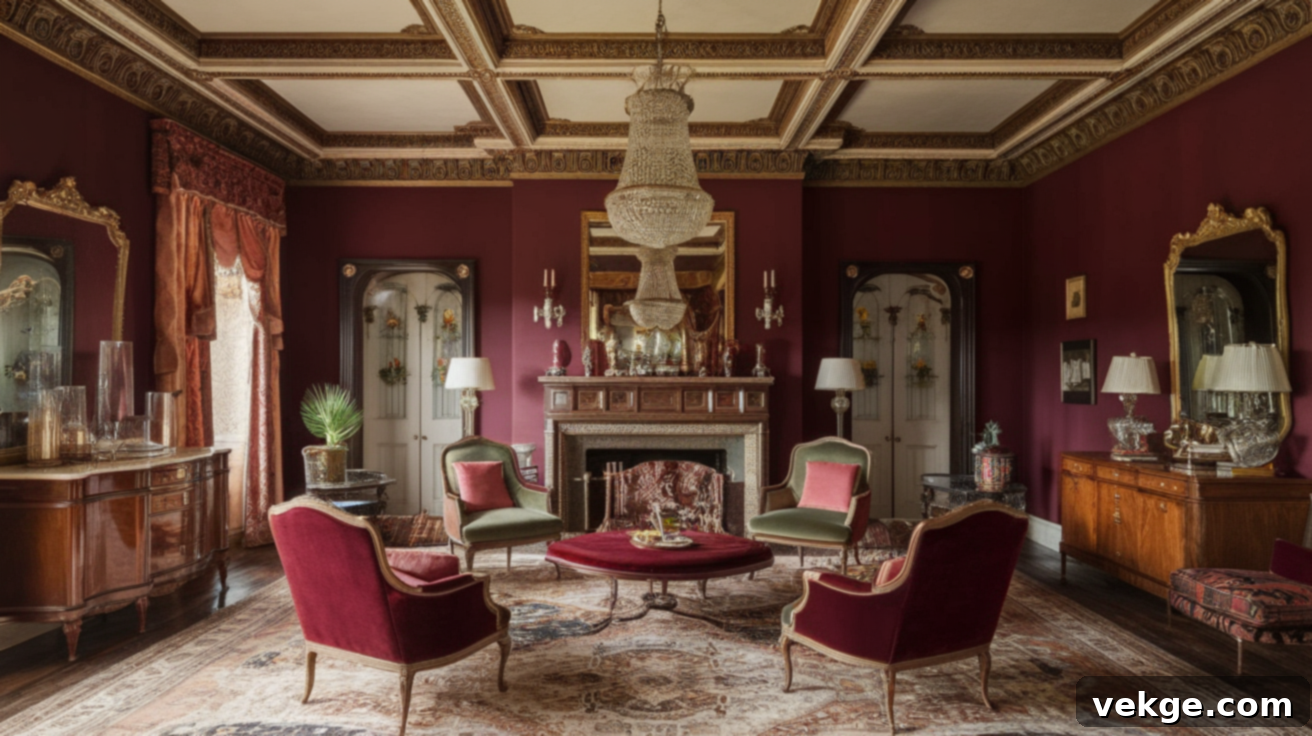Timeless Elegance: 39 Victorian Sitting Room Ideas to Transform Your Home
Dreaming of a home with an old-world charm, steeped in history and comfort? I’ve always been captivated by the allure of a Victorian sitting room – a space defined by its rich colors, warm, inviting lighting, and furniture that exudes genuine character. It’s a style that speaks of grandeur yet feels incredibly cozy.
If you’re drawn to this layered, luxurious aesthetic, you’re in good company. The good news is, you don’t need a sprawling mansion or a vast antique collection to bring this elegant style into your own space. With thoughtful choices and a few key elements, you can create a Victorian-inspired sanctuary, even in a modern home.
This comprehensive guide will walk you through 39 simple yet impactful ideas to infuse Victorian style into your living room. From selecting deep, inviting wall colors to choosing beautifully curved chairs and intricate patterned rugs, we’ve got you covered. Whether you aim for a bold, immersive Victorian experience or just wish to incorporate a few classic, timeless touches, you’ll find inspiration here.
Before we delve into specific design ideas for blending classic Victorian charm with contemporary living, let’s establish a clear understanding of what truly defines this iconic style. Knowing its core principles will be instrumental in helping you craft a cohesive and authentic look.
What Defines a Victorian Sitting Room?
Victorian sitting rooms, prominent during Queen Victoria’s reign (1837-1901), served dual purposes: as formal spaces for entertaining guests and as comfortable havens for family relaxation. These rooms were renowned for their elaborate and rich decoration, often filled with a carefully curated collection of furniture and decor, reflecting the owner’s status and taste.
Key characteristics that defined these opulent spaces included:
- Dark Wood Furniture: Pieces crafted from rich woods like mahogany, walnut, and rosewood, often featuring intricate carvings and elegant curved designs.
- Ornate Wall and Ceiling Moldings: Elaborate plasterwork, cornices, and ceiling medallions that added architectural interest and a sense of grandeur.
- Heavy Curtains and Upholstery: Luxurious fabrics such as velvet, brocade, and damask, often layered, providing both comfort and insulation.
- Deep, Jewel-Toned Colors: A preference for rich, saturated hues like burgundy, emerald green, royal blue, and deep purple, which created a warm and intimate atmosphere.
- Symmetrical Furniture Layouts: A formal arrangement of furniture, typically centered around a fireplace, emphasizing balance and order.
Furniture was meticulously arranged to reflect social customs, with distinct seating options for men and women. Taller chairs with armrests were traditionally for gentlemen, while lower, often more delicate seats were designed for ladies.
These rooms were masterfully layered with decorations, from richly patterned rugs that covered most of the floor to detailed accessories and artworks. Every element contributed to an overall sense of abundance, reflecting the family’s prosperity, cultural interests, and personal style.
Top Victorian Sitting Room Ideas
Ready to infuse your sitting room with that coveted cozy, classic, and sophisticated Victorian feel? Explore these inspiring ideas, focusing on key elements like soft yet rich colors, layered decor, and sumptuously comfortable, often curved, furniture pieces.
1. Deep Burgundy Walls
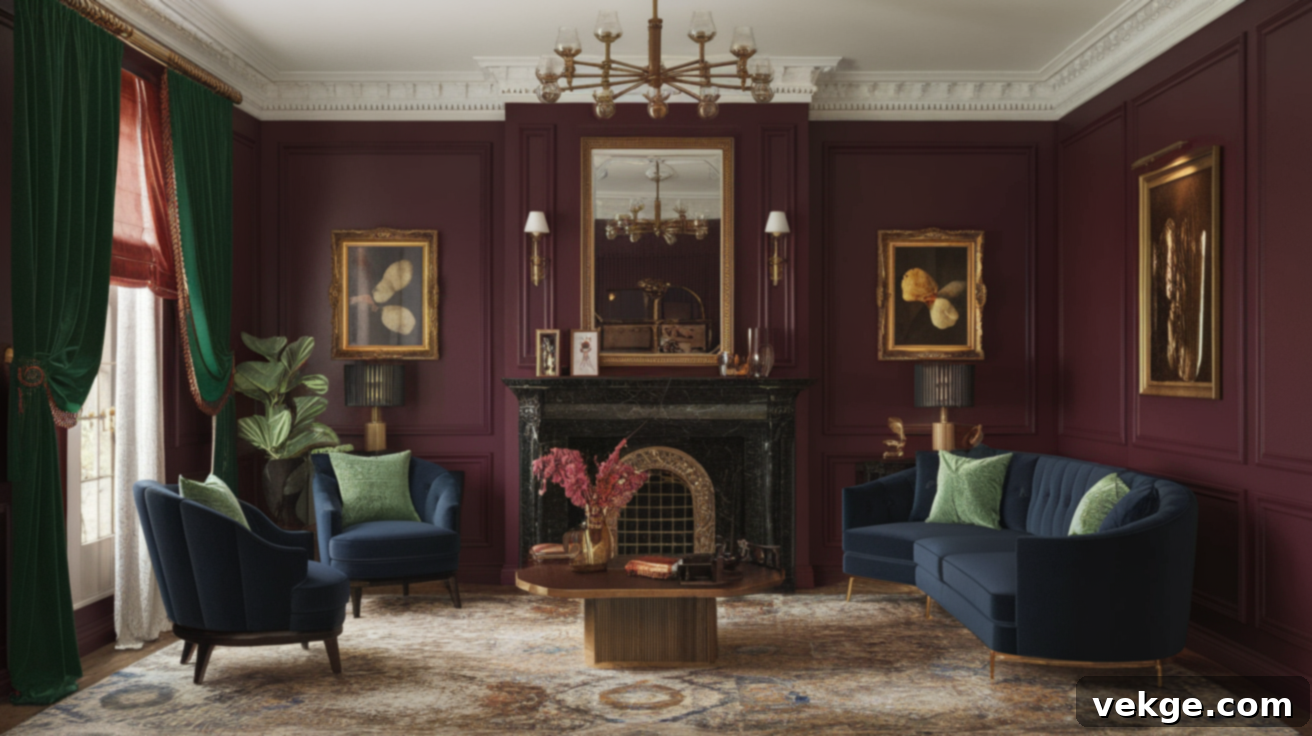
Deep burgundy walls are a cornerstone of traditional Victorian design, immediately establishing a rich, warm, and inviting backdrop. This regal color beautifully complements dark woods such as mahogany or walnut, enhancing their natural beauty and adding to the room’s historic charm. Beyond its aesthetic appeal, burgundy is excellent for highlighting gold-framed art and mirrors, making them truly pop against its depth. It’s a versatile choice, feeling incredibly cozy during colder months yet surprisingly sophisticated and not overwhelming for summer, making it an ideal year-round shade.
2. Emerald Green Accents
Emerald green, a vibrant and luxurious jewel tone, breathes life and energy into Victorian spaces. It can be introduced through various elements like upholstery, drapes, or smaller decorative accents. This rich green pairs exceptionally well with dark wood furniture and lustrous brass fixtures, creating a harmonious and elegant contrast. The color evokes a sense of nature and organic beauty while maintaining the room’s inherent formality. Incorporate it strategically in cushions, decorative lampshades, or even sophisticated plant containers to introduce this striking shade without making the space feel too heavy or overly dark.
3. Navy and Brass Pairing

The combination of deep navy blue with the warm glow of brass creates a classic Victorian look that feels remarkably fresh and current. Navy walls or a substantial navy furniture piece provide a strong, elegant backdrop, perfect for showcasing treasured collections or artwork. Brass elements, such as intricate door handles, elegant lamps, or classic picture frames, introduce points of light and warmth, beautifully balancing the cool undertones of the navy. This sophisticated pairing is wonderfully versatile, working effectively in both expansive living rooms and more intimate sitting areas, adding depth and a touch of refined glamour.
4. Dusty Rose Trim Details
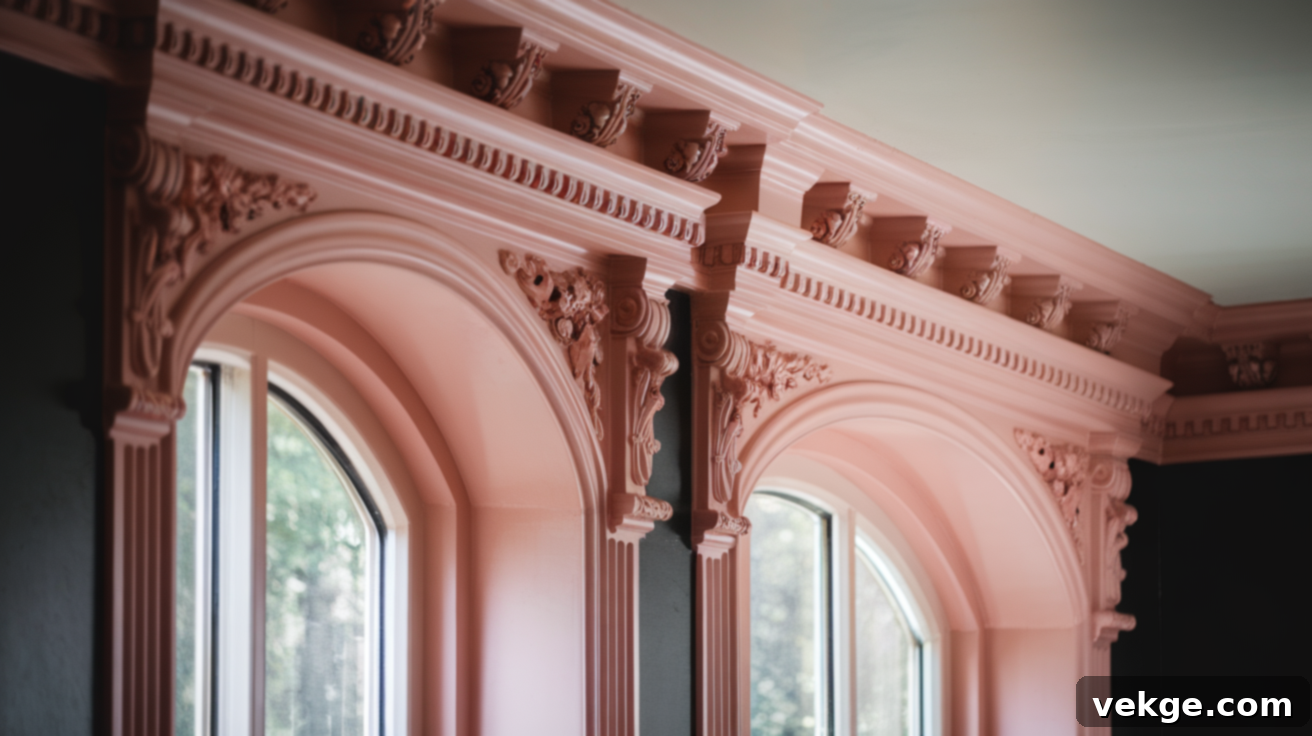
For a softer, more delicate touch of Victorian charm, consider incorporating dusty rose into your trim details. This muted, gentle pink hue can add a subtle yet captivating color to crown molding, door frames, and window trim. It offers a beautiful contrast against crisp white walls or provides a gentle lift when paired with darker, more dramatic backgrounds. Dusty rose introduces a feminine elegance without feeling overly sweet or childish, enhancing Victorian architectural details with nuanced color interest that is both understated and sophisticated.
5. Moody Charcoal Neutrals
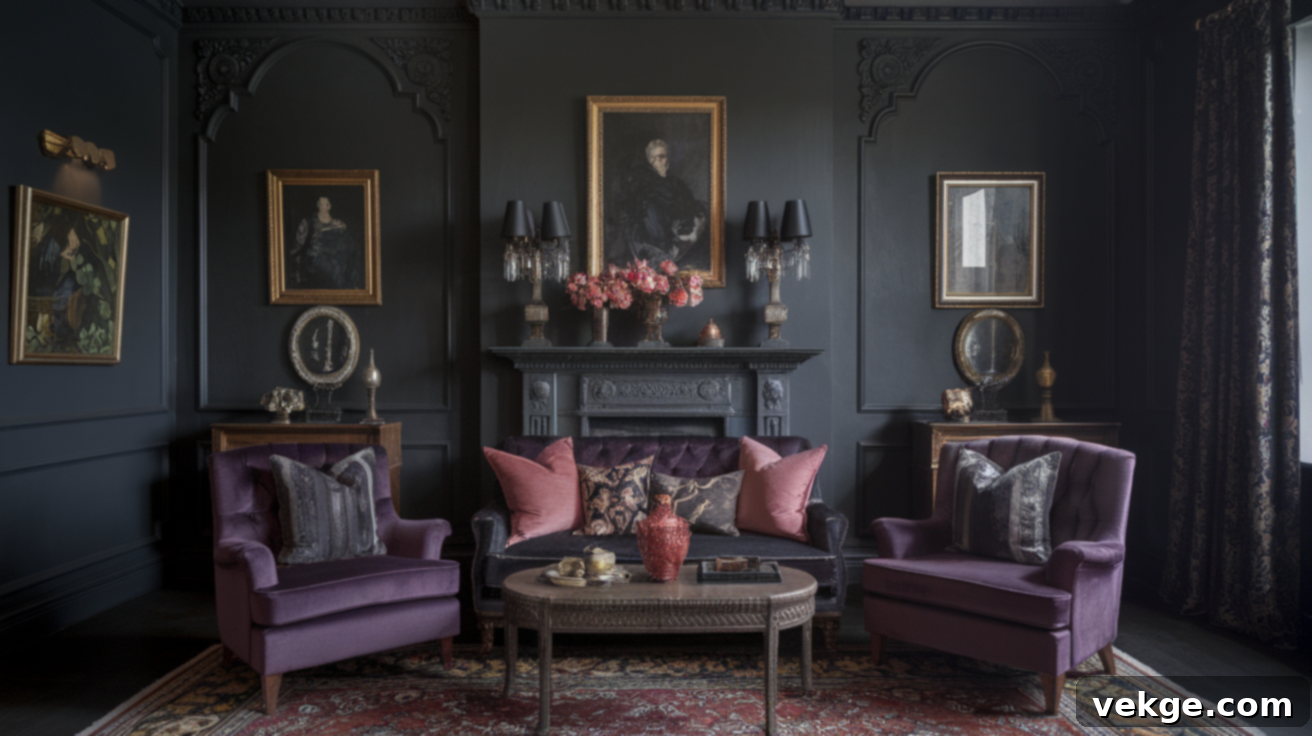
Utilizing moody charcoal paint or fabric offers a sophisticated and contemporary take on Victorian aesthetics while retaining a classic feel. This deep, rich gray provides a striking contrast with pristine white ceilings and trim, creating a modern edge. When applied to walls or featured on key furniture pieces, charcoal establishes a bold and dramatic backdrop that allows traditional Victorian elements, such as richly patterned rugs and ornate, dark wood furniture, to truly shine. It creates an atmosphere of depth and introspection.
6. Gold and Cream Ceiling Treatment
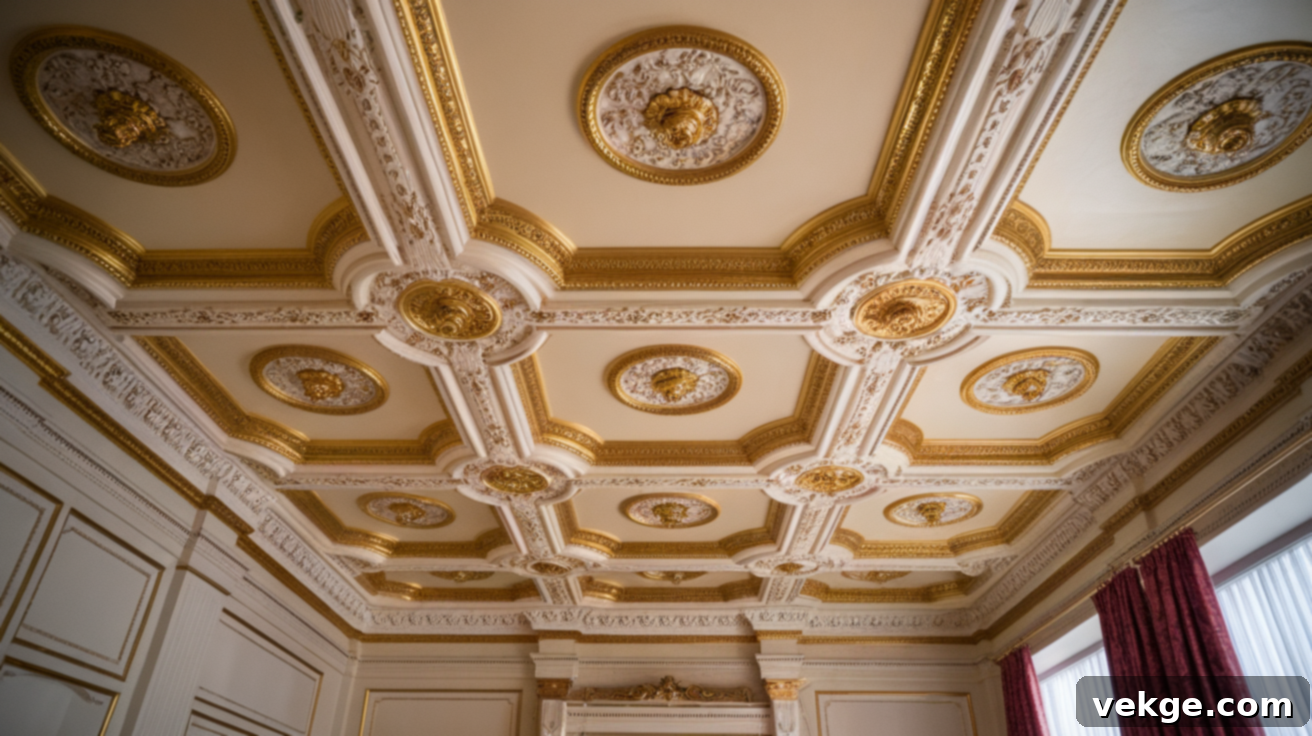
In Victorian design, ceilings were often considered the “fifth wall” and treated with as much decorative attention as the others. A gold and cream ceiling treatment draws the eye upwards, celebrating overlooked architectural details. Gold medallions, cornices, and delicate trim against a soft cream background create a sense of grandeur that is rich yet not ostentatious. These lighter tones also have the practical benefit of reflecting more light throughout the room, brightening the space while impeccably maintaining its formal and elegant Victorian style.
7. Tufted Velvet Sofa
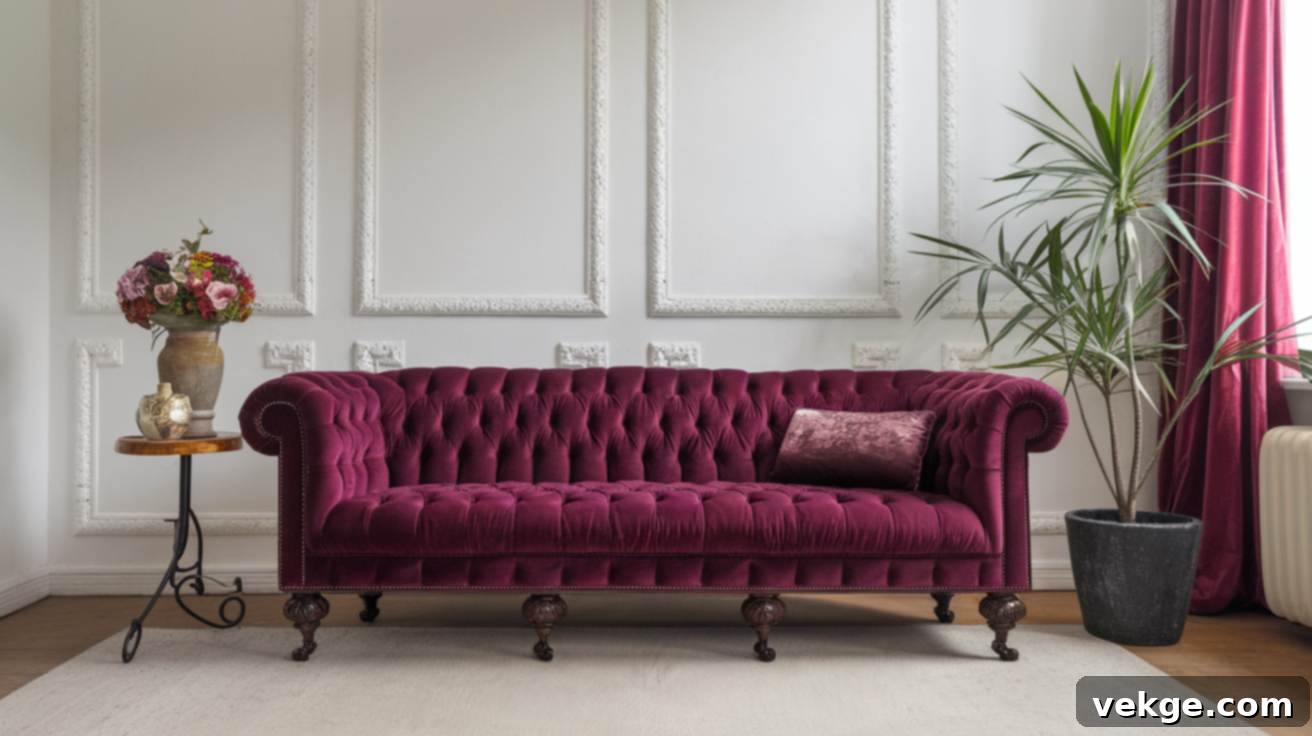
The tufted velvet sofa is undeniably a quintessential piece of Victorian furniture, instantly recognizable and synonymous with luxury. Its distinctive deep buttoning, which creates an elegant diamond pattern across the back and arms, is an iconic design detail. These sofas frequently feature gracefully rolled arms and exquisitely carved wooden feet, sometimes adorned with the charming claw-and-ball motif. Modern interpretations may streamline the legs but retain the essential tufting. Velvet itself is a highly tactile fabric that shifts beautifully with the light, adding depth, texture, and visual interest, even in a subtly designed space.
8. Gentleman’s Wingback Chair
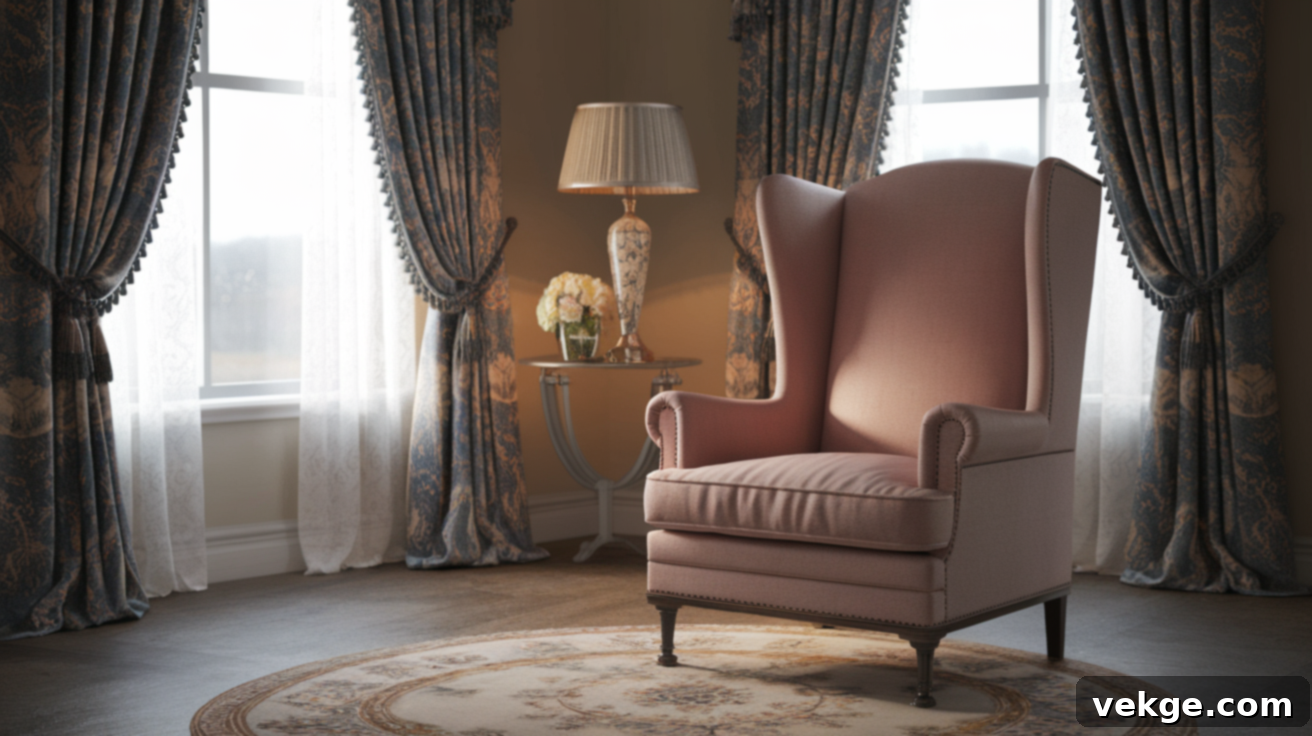
Victorian homes often featured distinct seating arrangements, and the gentleman’s wingback chair was a staple. Characterized by its generous proportions, taller stature, and supportive arms, it was designed for comfort and presence. Its high back and distinctive side wings served a practical purpose, trapping heat from the fireplace and protecting against drafts. Contemporary versions maintain this classic, imposing silhouette but often incorporate enhanced padding and more ergonomic designs for superior modern comfort, making them a perfect statement piece in any sitting room.
9. Curved Mahogany Coffee Table
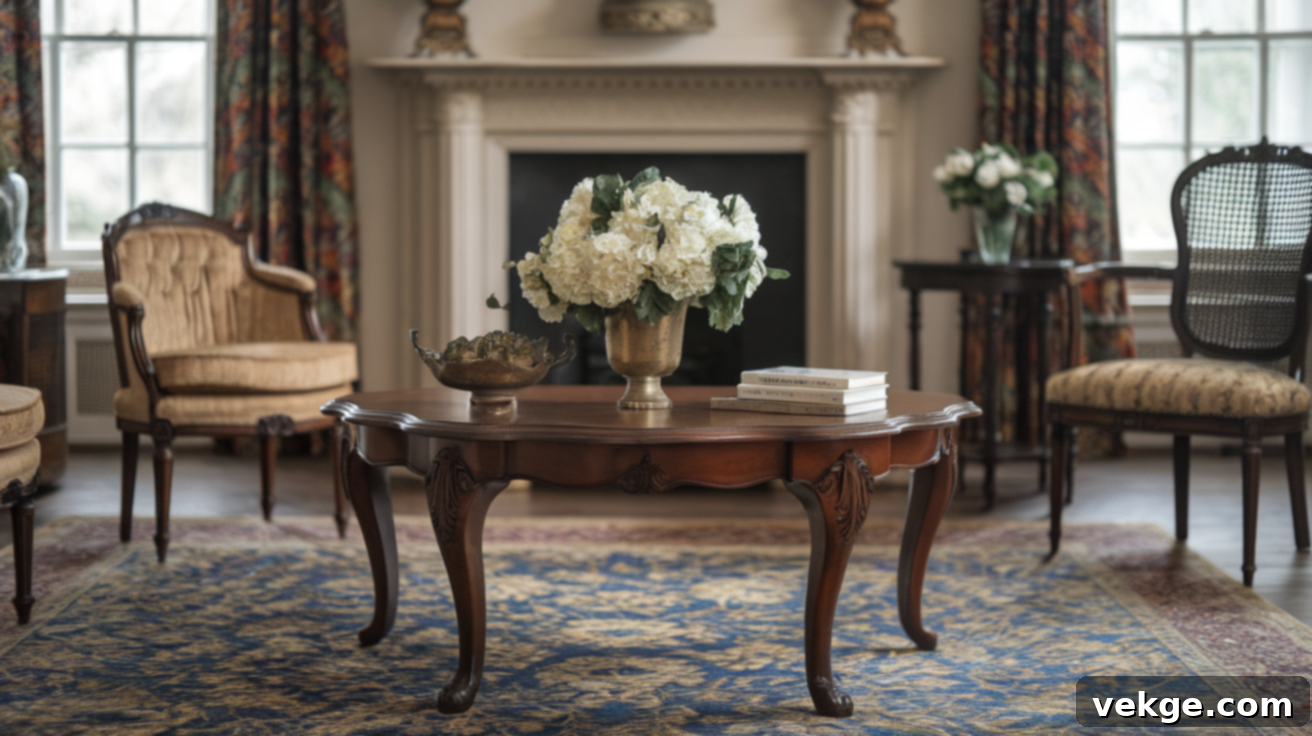
Victorian coffee tables were often masterpieces of woodworking, showcasing exquisite craftsmanship through their gracefully curved legs and intricate ornate details. Mahogany was a particularly favored wood, prized for its deep, lustrous color and its suitability for detailed carving. These tables frequently boasted carved edges, delicate scrollwork, and sometimes even featured luxurious marble insets. The elegant curved lines helped to soften rooms that might otherwise be dominated by more angular furniture. Modern designs often simplify the tabletop for practical daily use while preserving the distinctive, carved legs that define their Victorian charm.
10. Settees and Fainting Couches
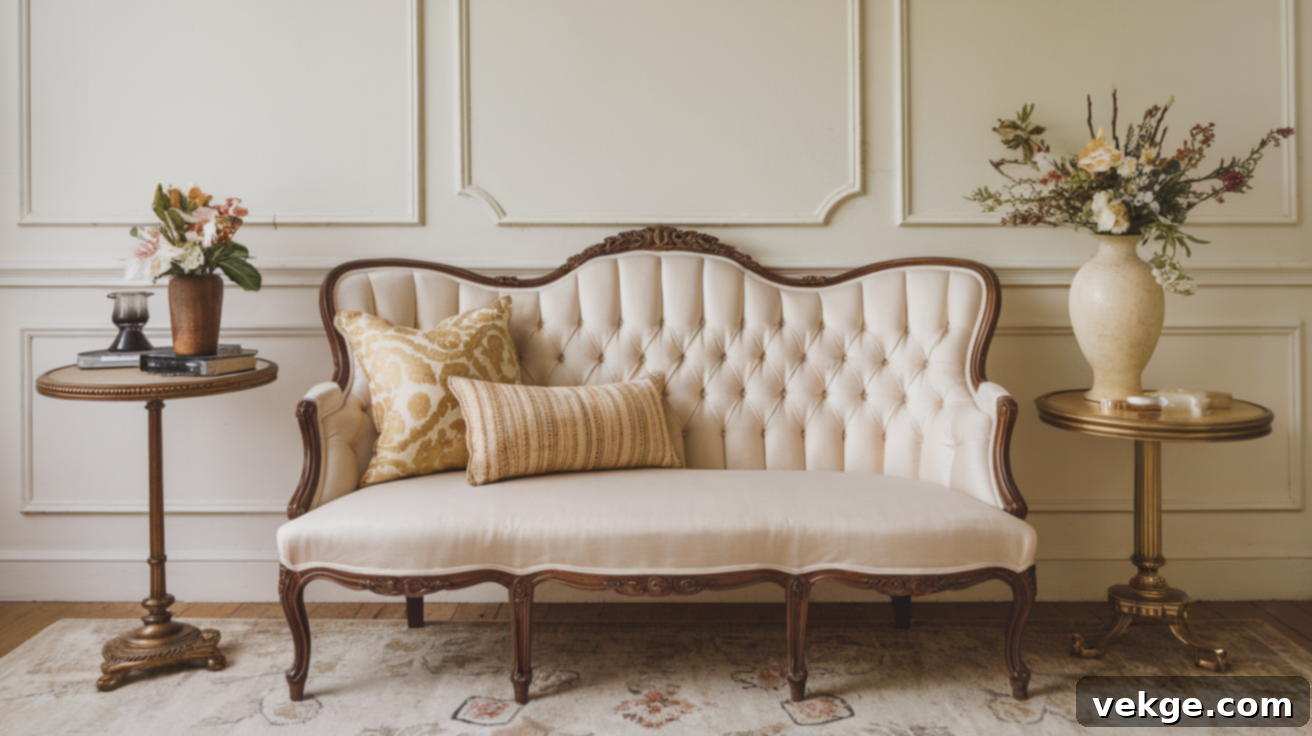
Settees and the unique fainting couches, often featuring an armrest on only one side, were common and highly functional pieces in Victorian sitting rooms. The design of the fainting couch, with its characteristic sloping backrest that typically ended flat, allowed corseted women to recline comfortably when feeling unwell or simply to rest. Both settees and fainting couches are defined by their beautifully carved wood frames, often visible, and luxurious button tufting, which collectively articulate their unmistakable Victorian style. They provide elegant, often space-saving, seating options.
11. Upholstered Footstools with Tassels
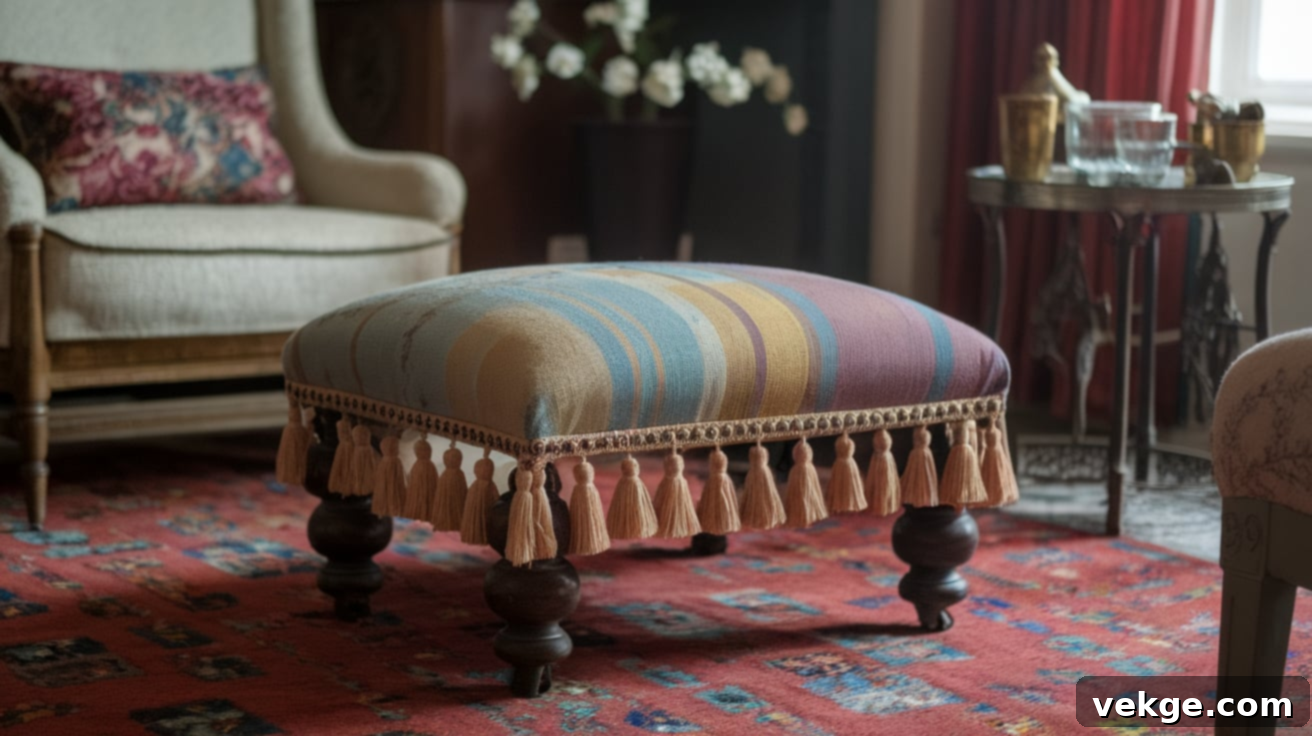
Small, upholstered footstools, often adorned with playful tassels, served both practical and decorative roles in Victorian interiors. These charming pieces typically featured sturdy wooden feet and a padded fabric top, frequently showcasing intricate needlepoint or rich tapestry designs. The addition of tassels provided a delightful touch of color and movement to an otherwise static space. In contemporary settings, these versatile footstools can double as compact coffee tables or provide extra seating when entertaining. Their modest size also makes them exceptionally easy to reposition as needed, adding flexible style.
12. Marble-Top Side Tables

Victorian side tables featuring crisp white marble tops supported by dark wood bases were clear indicators of wealth and refined taste. The striking contrast between the pristine marble and the rich, dark wood added significant visual interest and proudly showcased imported, high-quality materials. These tables frequently incorporated elegant curved legs and often included lower shelves, perfect for displaying small, prized possessions. Today, they function beautifully as sophisticated lamp stands or convenient spots for drinks, all while effortlessly preserving their timeless, classic appeal.
13. Eastlake-Style Armoires
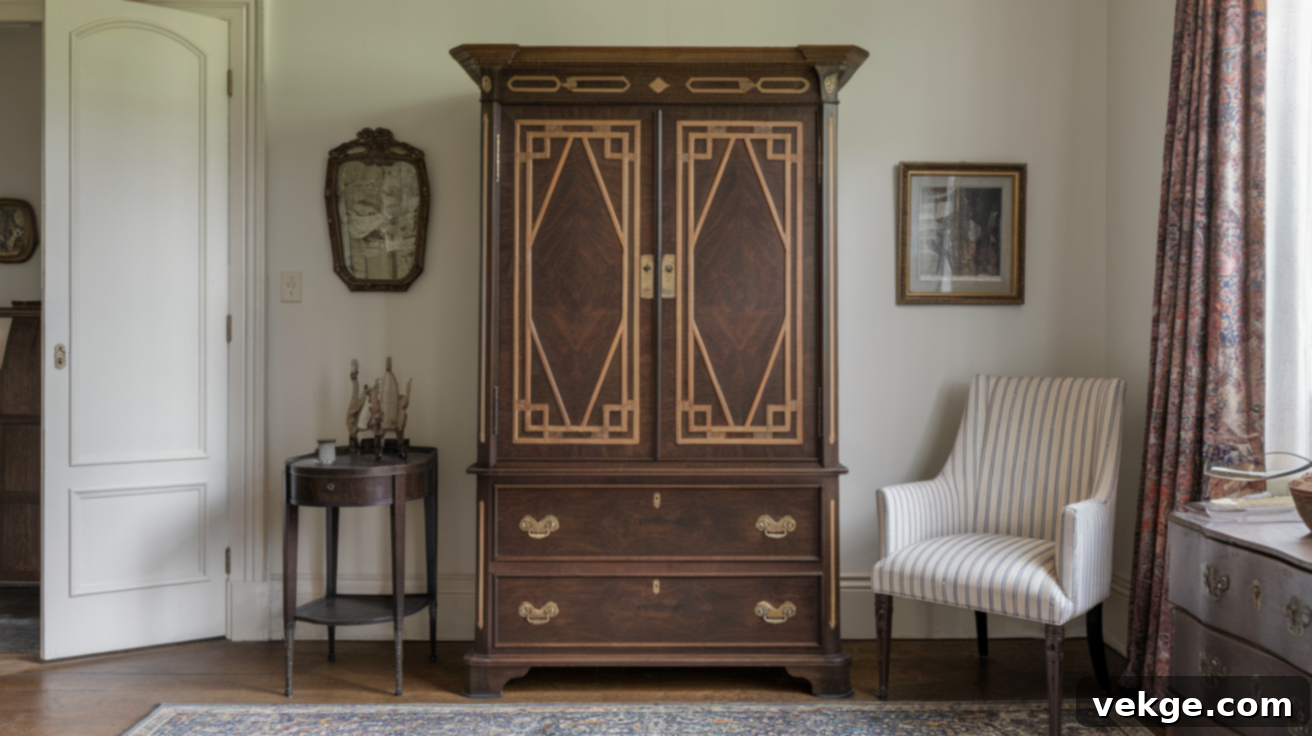
Eastlake-style armoires offered practical and aesthetically pleasing storage solutions in Victorian sitting rooms, distinguishing themselves with their characteristic straight lines and distinctive geometric patterns. In contrast to the elaborate curved designs of earlier periods, Eastlake furniture featured flat panels, incised carvings, and clean, angular details. They were often enhanced with refined brass hardware and sometimes included mirrored doors, adding both functionality and a touch of sparkle. Today, these armoires are highly versatile, serving beautifully as elegant TV cabinets, or discreet storage for games, books, or linens, all while contributing a strong period look to any room.
14. Damask Wallpaper in Rich Tones
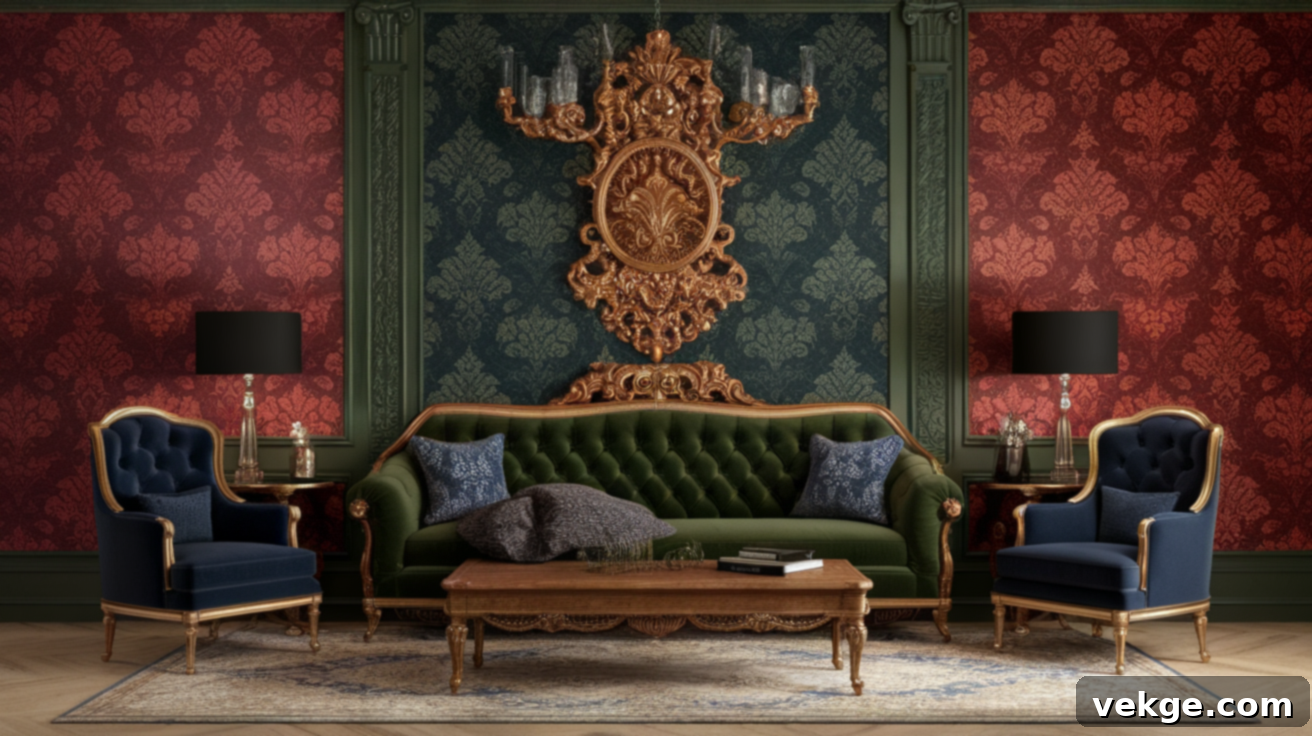
Damask wallpaper is a hallmark of Victorian interior design, adding both intricate pattern and incredible depth to walls. The raised, woven design catches the light in fascinating ways, creating a subtle texture that shifts throughout the day. Opting for rich colors like deep red, forest green, or royal blue immediately sets a luxurious and opulent tone for the entire room. Modern versions of damask wallpaper may even incorporate subtle metallic finishes, which shimmer elegantly in ambient light. To achieve balance, use damask on primary walls and keep adjacent surfaces or trim relatively simple, allowing the pattern to truly command attention.
15. Floral Wallpaper with Metallic Accents
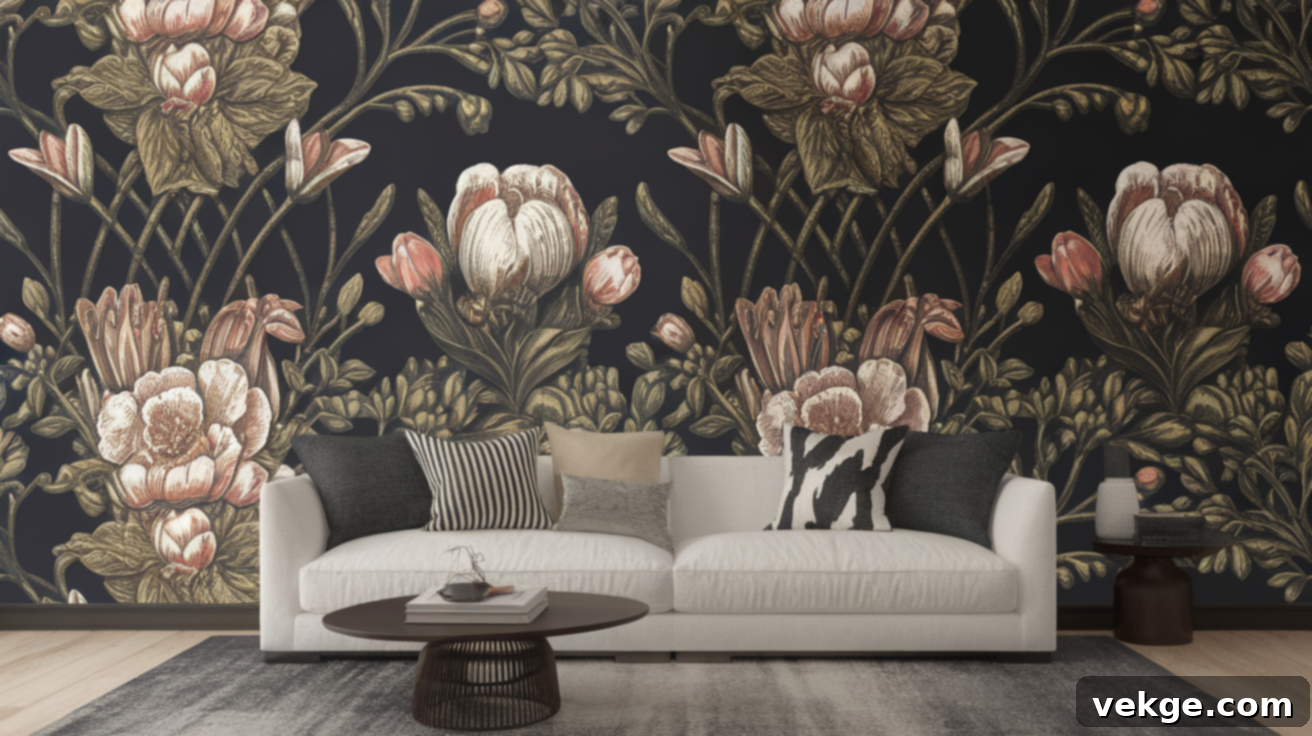
Large-scale floral patterns were a beloved feature in Victorian rooms, covering walls with botanical beauty. Contemporary floral wallpapers often enhance this classic design with metallic accents incorporated into the stems, leaves, or flower centers, adding a subtle, sophisticated shimmer. These designs typically focus on detailed, naturalistic botanical illustrations rather than abstract shapes, capturing the Victorian fascination with nature. They are remarkably versatile, working well in both expansive rooms and cozy alcoves, adding depth and visual interest to otherwise plain areas. For a daring modern twist, consider bold color combinations such as a dramatic black background with shimmering gold flowers, creating a truly striking effect.
16. Painted Beadboard Half-Walls
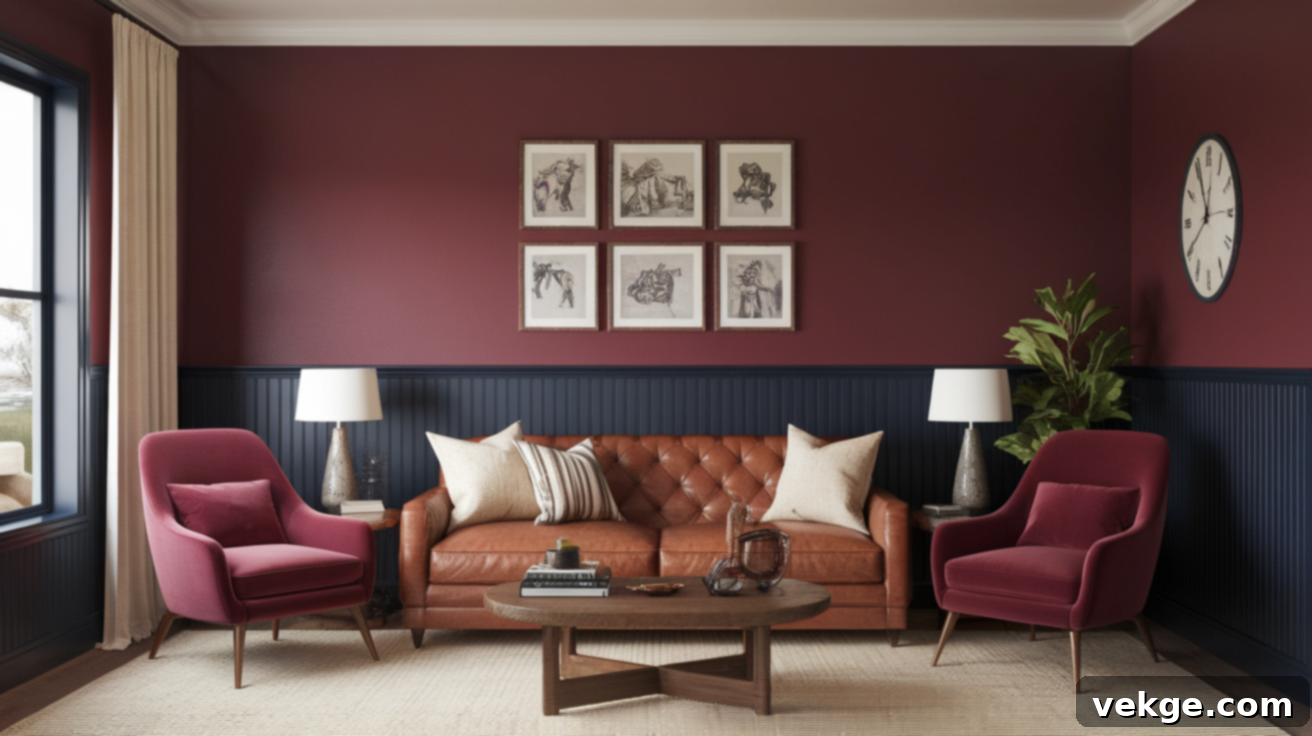
Beadboard half-walls, a characteristic Victorian feature, are not only aesthetically pleasing but also highly practical. Painted in bold, rich colors, they add appealing texture and provide durable protection for walls in high-traffic areas. The upper half of the wall can be beautifully complemented with wallpaper or painted in a contrasting color, creating a distinctive visual break. The vertical lines of the beadboard introduce an elegant sense of height and visual interest. For an authentic and refined look, choose classic Victorian shades like dark green, deep burgundy, or navy, and use a crisp white trim to elegantly separate the beadboard from the upper wall section.
17. Framed Wall Panels with Gilded Trim
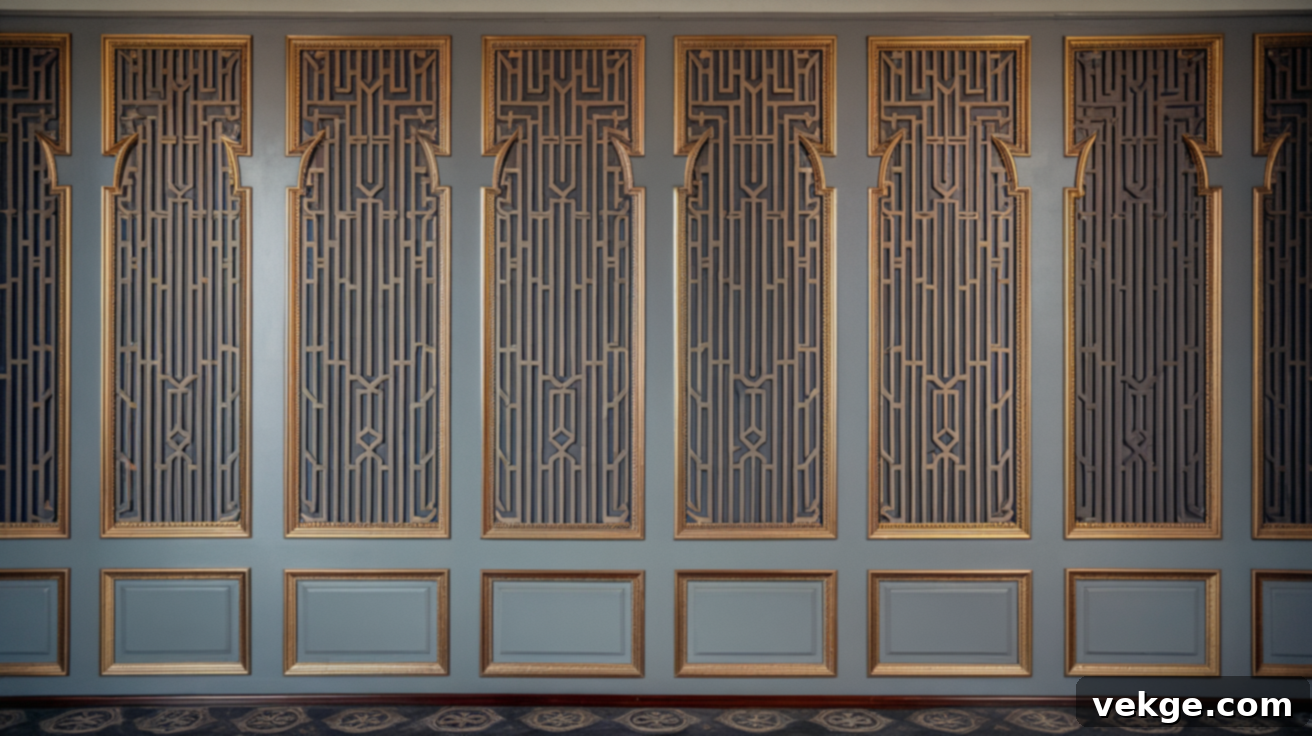
Victorian walls frequently utilized decorative wood trim to create elegant framed panels, a sophisticated technique for breaking up large expanses into more intimate and detailed sections. Applying gold or silver paint to this trim immediately elevates the look, creating a rich, almost picture-frame effect around each panel. Within these panels, you can introduce a variety of textures and colors: patterned wallpaper, luxurious fabric, or a contrasting paint shade. This design choice is particularly effective in formal dining and sitting rooms, where guests are likely to appreciate the intricate details and craftsmanship.
18. Ceiling Medallions with Chandeliers
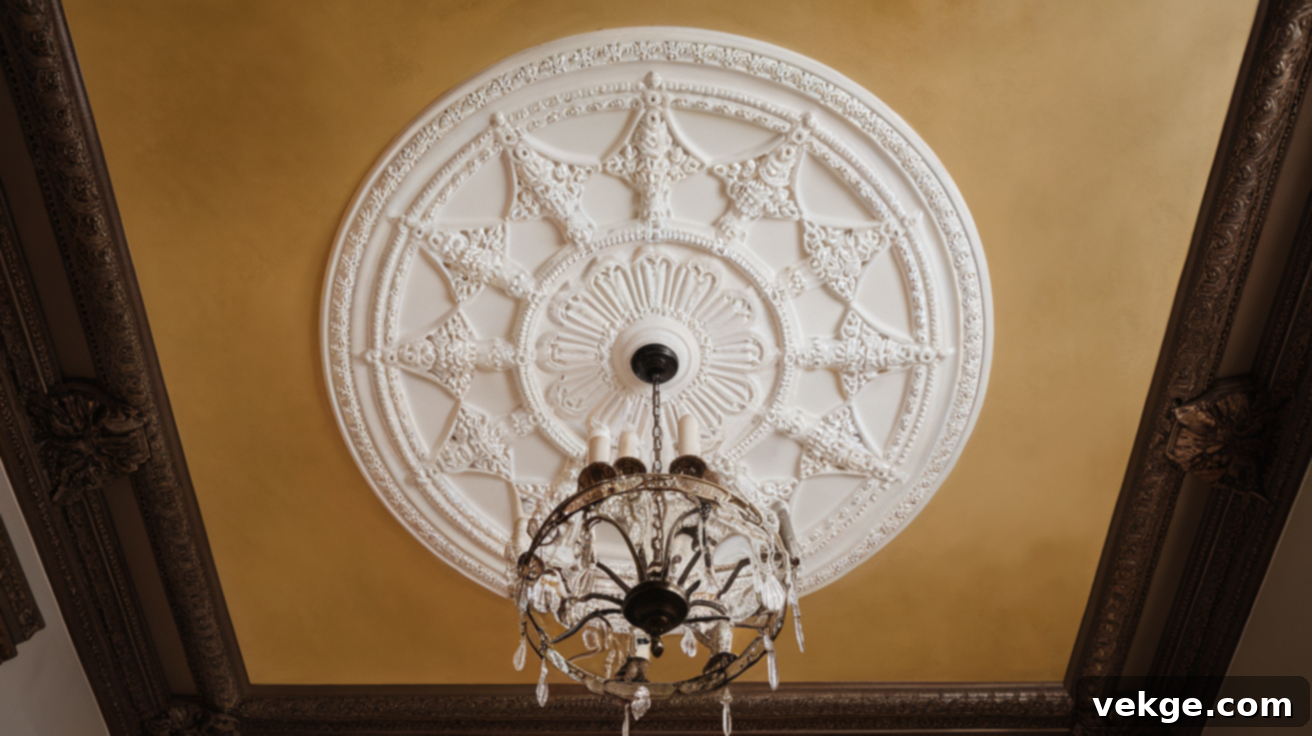
Ceiling medallions are stunning architectural elements that serve to highlight light fixtures, radiating out from the center with beautifully layered plaster designs. In Victorian homes, these elaborate medallions were essential, framing gas lamps and early electric lights, adding both beauty and a sense of importance. Today, incorporating a ceiling medallion instantly imbues a room with period style and a touch of classical elegance. While most are traditionally white, they can be painted to match surrounding trim or subtly accented with gold or silver to enhance their intricate details, truly drawing attention to your chosen chandelier.
19. Ornate Molding Painted in Two Tones
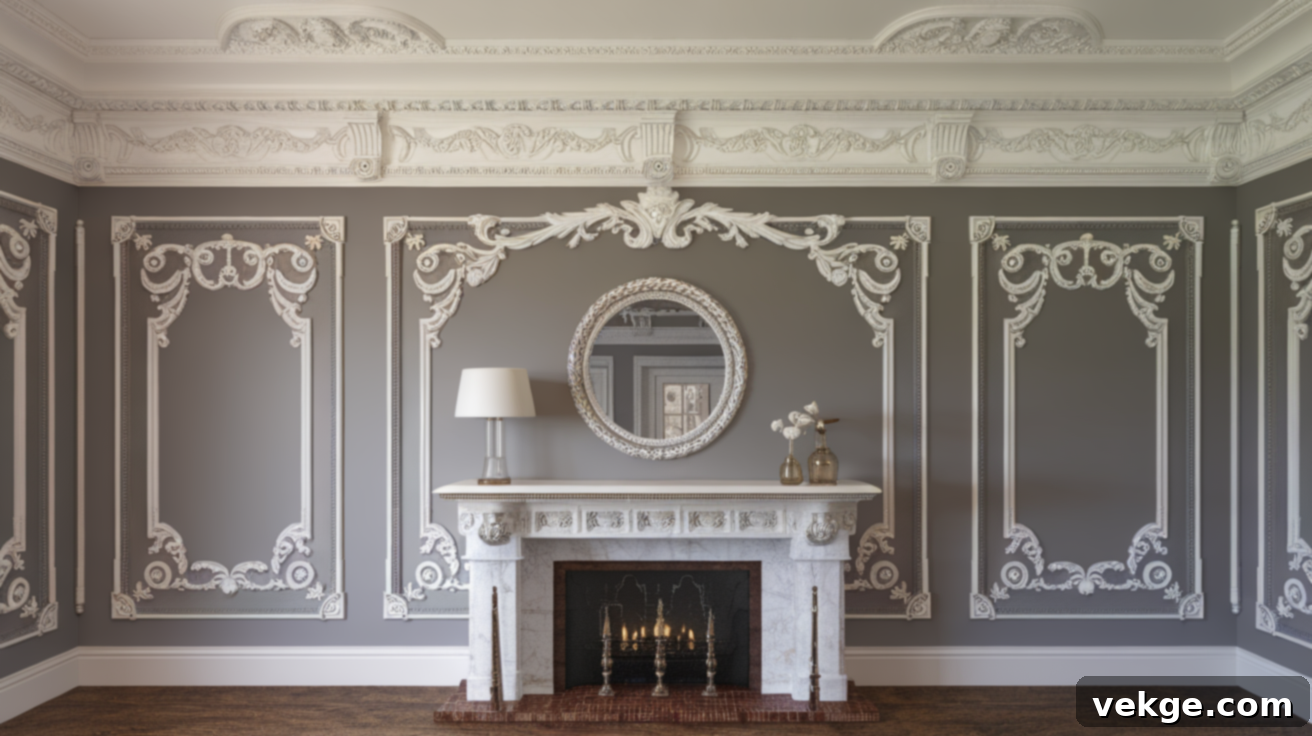
To truly emphasize the intricate depth and elaborate details of Victorian trim, consider painting ornate molding in two complementary tones. By applying different shades to the raised and recessed areas of the molding, you can create captivating shadow effects that shift and play with the light throughout the room. Popular combinations include classic cream and white, elegant gray and silver, or dramatic dark tones accented with gold. This technique transforms what might be basic trim into exquisite decorative frames for your walls, windows, and doors, adding layers of visual richness.
20. Persian or Oriental Rugs
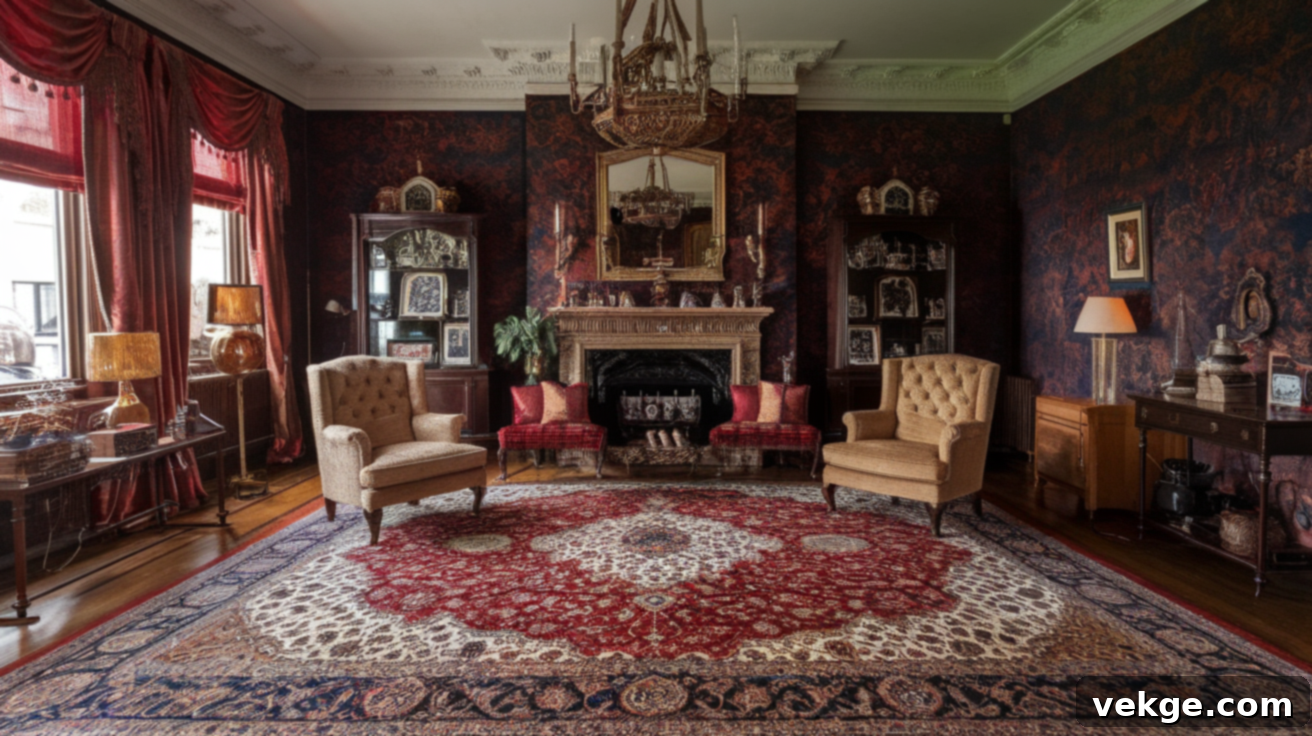
Persian and Oriental rugs were indispensable in Victorian sitting rooms, introducing rich patterns, vibrant colors, and luxurious texture to the floors. These exquisite rugs often featured elaborate central medallions and intricately detailed borders, acting as true works of art. Traditional colors like deep red, majestic blue, and warm gold were favored, not only for their beauty but also for their ability to subtly disguise dirt and add significant warmth and comfort. It was not uncommon for Victorians to layer rugs of different sizes, creating a cozy and abundant feel. Today, these timeless rugs are perfect for unifying furniture groupings within a room, and even well-worn examples add character and a sense of history that new items cannot replicate.
21. Fireplace Mantel with Antique Clock
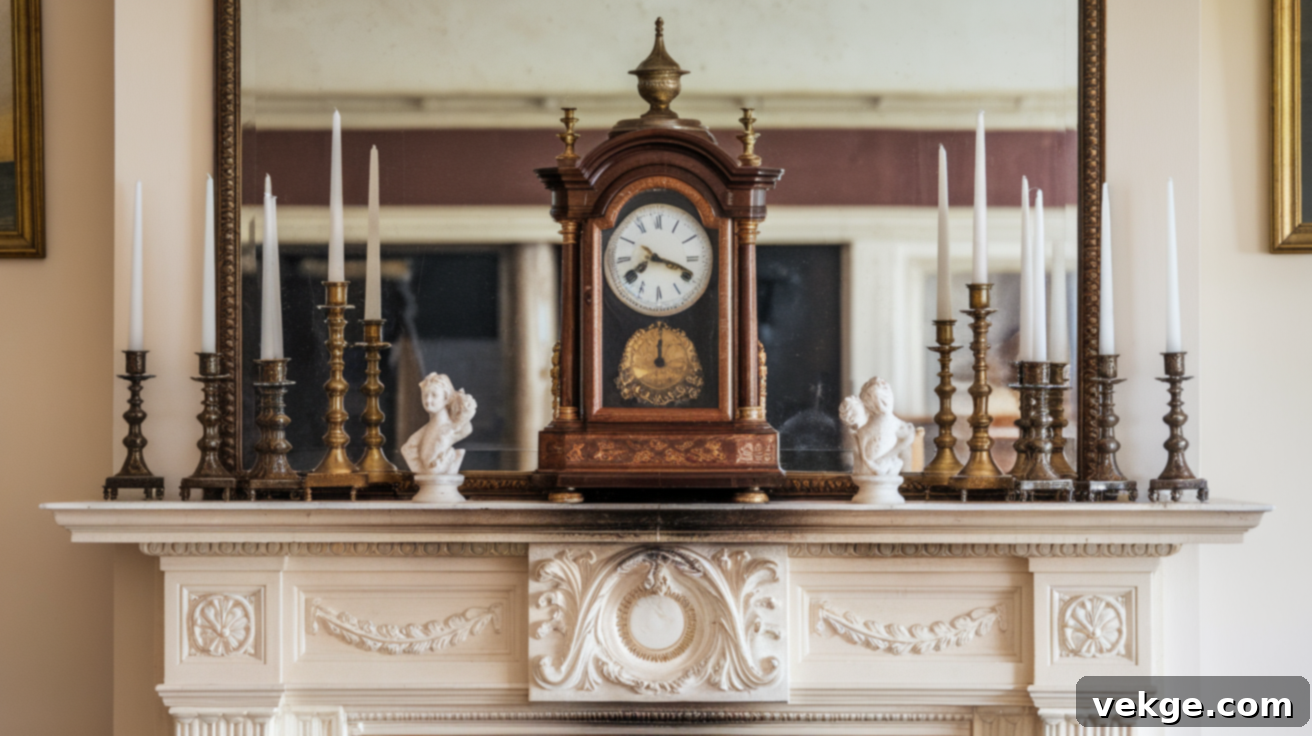
The fireplace mantel was the undisputed focal point of any Victorian sitting room, serving as a prominent stage for carefully arranged displays. At its center, an antique clock was typically placed, often flanked by a symmetrical pair of matching items such as elegant candlesticks, classical sculptures, or decorative urns. These clocks were frequently crafted from luxurious materials like polished marble, gleaming brass, or rich dark wood, often showcasing visible, intricate mechanics. Mantel displays strictly adhered to principles of balance and symmetry, with decorative items typically decreasing in height as they moved outward from the central clock, creating a pleasing visual flow.
22. Tassel Curtain Tiebacks
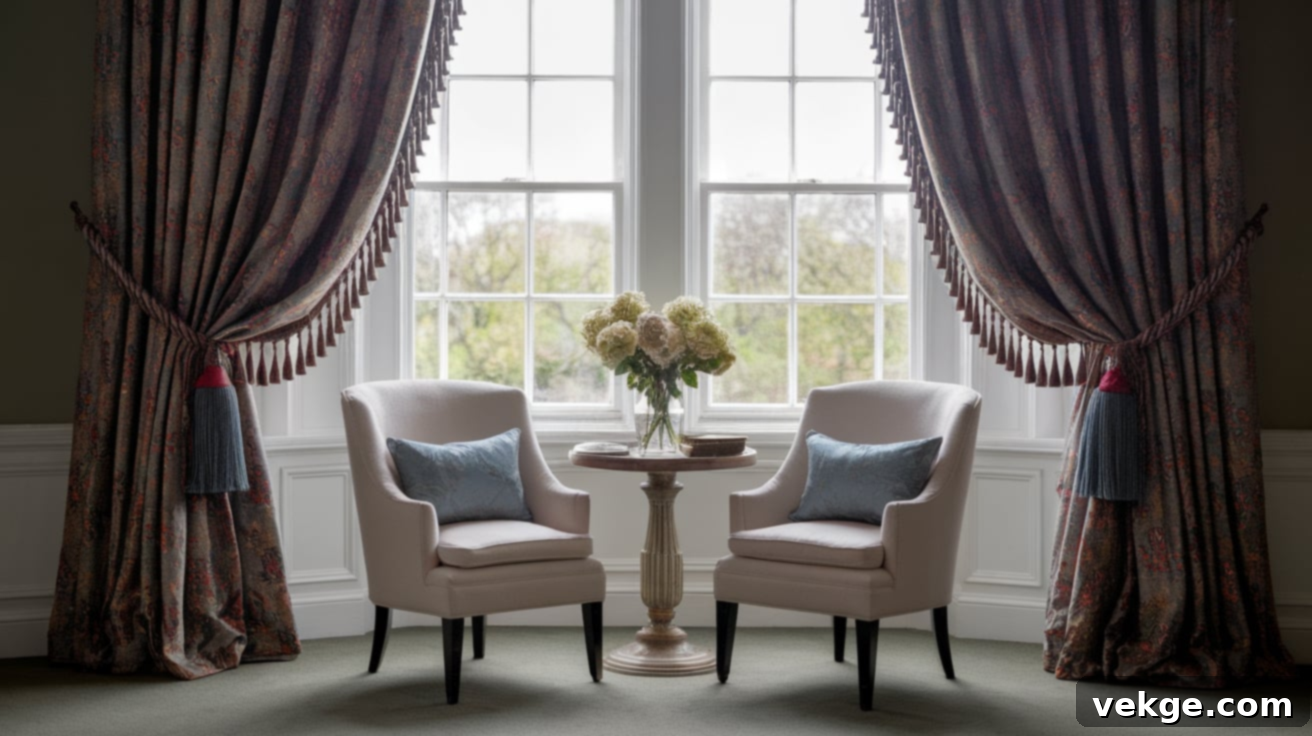
Tassel tiebacks were a charming and functional accessory in Victorian curtain treatments, adding both color and dynamic movement. Crafted from beautifully twisted silk or cotton cords, culminating in decorative tassels, these tiebacks served to gracefully pull back heavy drapes, allowing light to enter while contributing to the room’s lavish aesthetic. Their colors were typically chosen to either perfectly match or elegantly complement the curtains, and the tassels were usually positioned at seated eye level to maximize their visual impact. Modern interpretations may feature simpler designs, but they continue to fulfill the same purpose and contribute to a sophisticated, finished look for window treatments.
23. Gilded Mirror Over the Mantel
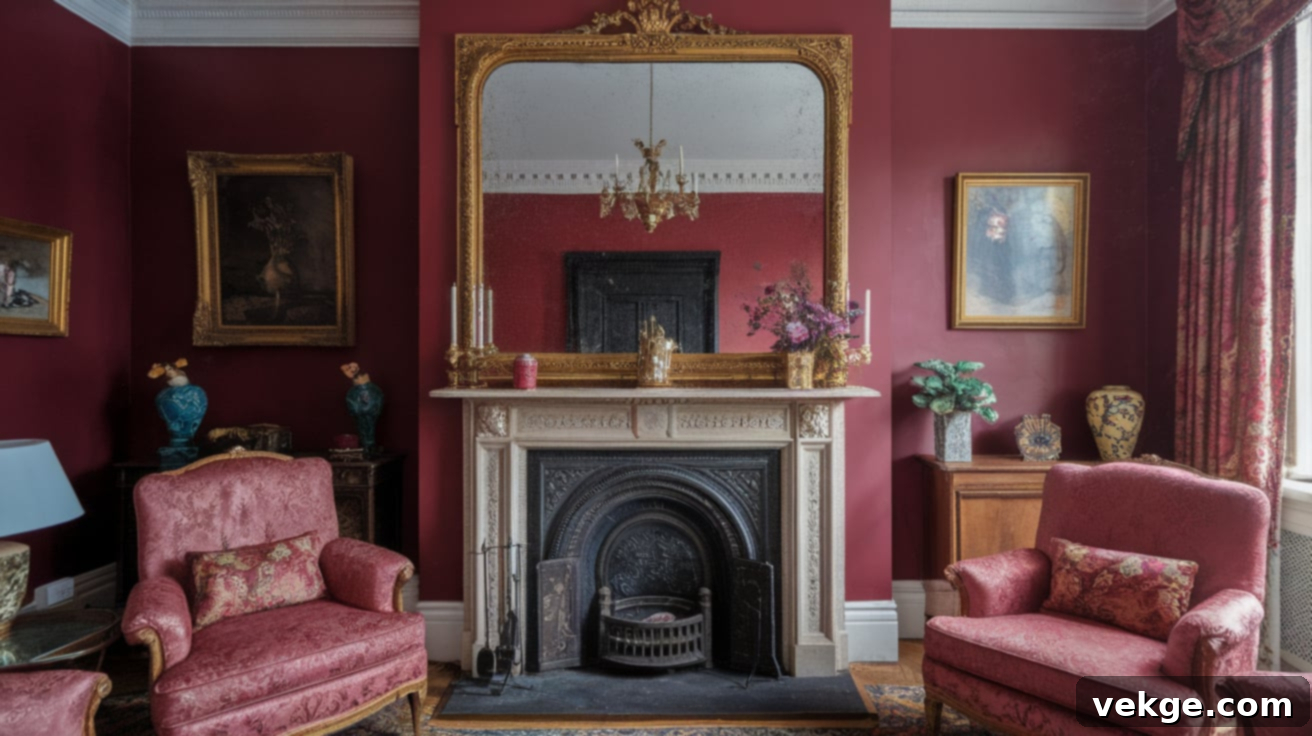
A grand gilded mirror positioned prominently above the fireplace was a staple in Victorian rooms, serving both a practical and profoundly decorative purpose. Before the widespread availability of electric lighting, these large mirrors were crucial for reflecting natural light from windows and artificial light from lamps, effectively brightening and expanding the perception of space. Their frames were typically adorned with multiple layers of gold leaf and intricate, ornate classical designs. While modern versions might feature simpler frames, they retain the essential large size and strategic placement. These magnificent mirrors consistently add light, sparkle, and a captivating sense of spaciousness to any sitting room, creating an immediate focal point.
24. Lace or Brocade Drapes

Victorian window treatments were characterized by their opulent layering of various fabrics, combining both function and elaborate style. Heavy brocade drapes, often trimmed with tassels or fringe, provided essential warmth, privacy, and a sense of luxury. Beneath these substantial drapes, delicate lace panels were frequently hung, allowing soft light and air to filter through while still offering a degree of seclusion. This strategic layering created a window treatment that appeared rich, full, and impeccably finished. Brocade fabrics showcased deep colors and intricate patterns, while lace displayed fine, delicate detail. Modern adaptations may opt for fewer layers but can still capture the richness and texture of these classic Victorian fabrics.
25. Oil Paintings in Gold Frames
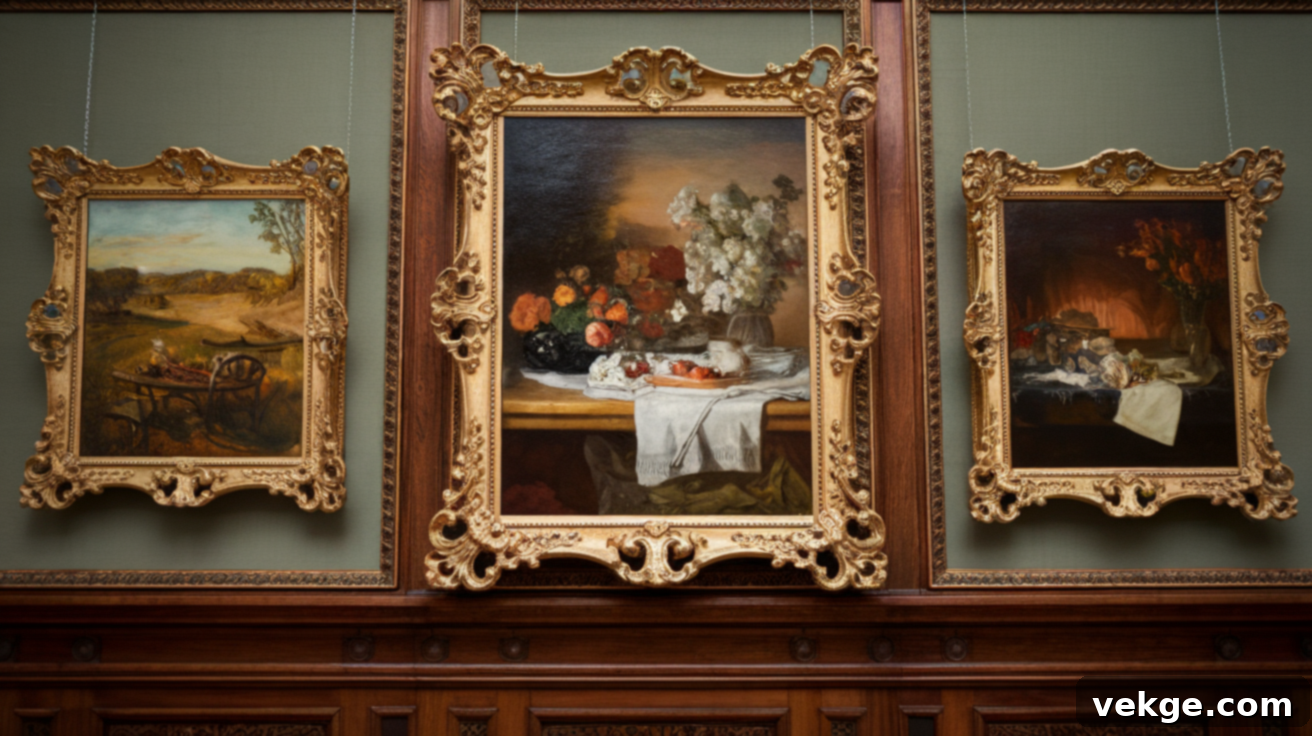
Oil paintings, encased in magnificent gold frames, were essential for bringing culture, color, and storytelling to Victorian walls. These artworks often depicted serene landscapes, detailed still lifes, or formal family portraits. The frames themselves were typically wide, with shimmering gold surfaces and exquisitely detailed corners and moldings, acting as an extension of the art. Paintings were traditionally hung from picture rails, rather than being nailed directly into the walls. This method often resulted in a slight forward tilt, which cleverly minimized glare from room lighting. In contemporary settings, incorporating vintage-style art or cherished family heirlooms in similar frames can achieve this same dignified and cultured look.
26. Crystal Candle Holders
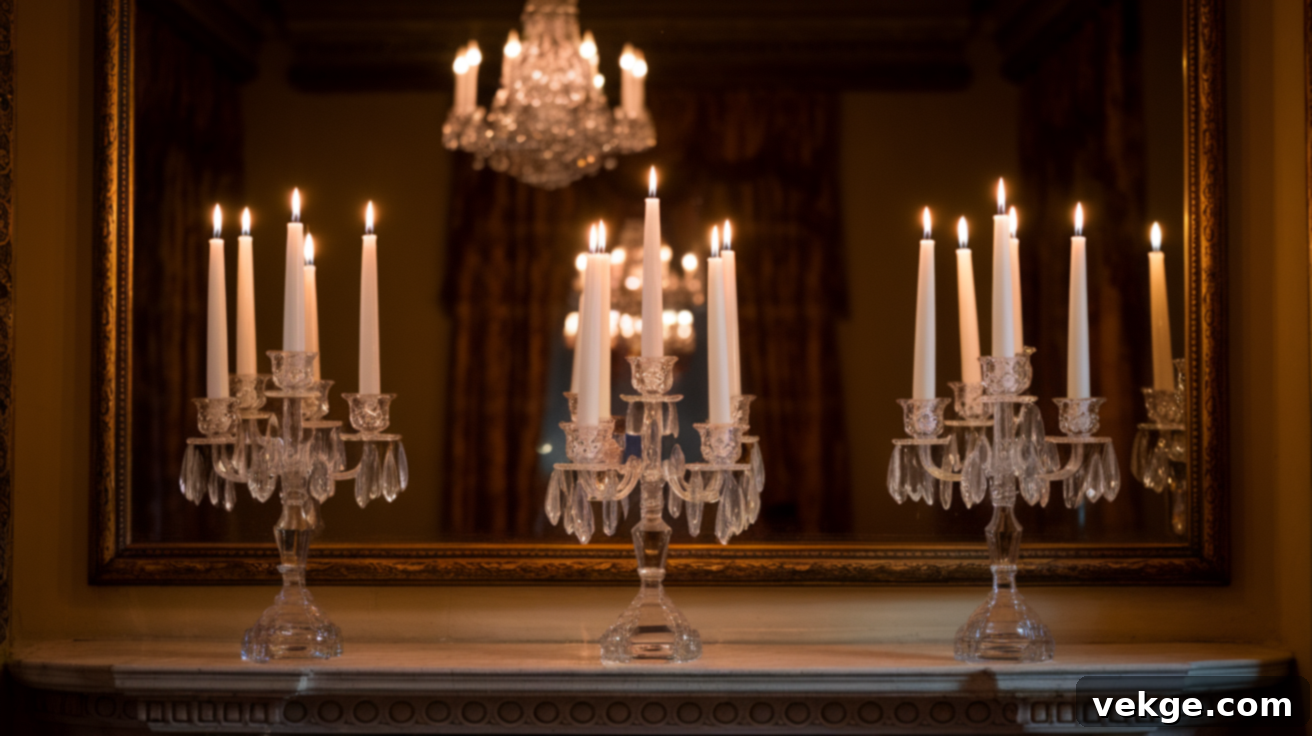
Crystal candle holders were indispensable accessories in Victorian rooms, adding a dazzling sparkle by beautifully reflecting candlelight. These elegant pieces ranged from single, stately holders to elaborate, branched candelabras. The faceted crystal amplified the soft glow of candles during evening gatherings, creating a magical ambiance, and were frequently placed on mantels, side tables, and dining tables. Today, they continue to bring a touch of timeless style, whether holding real wax candles for special occasions or battery-operated ones for everyday charm. Their intricate, light-catching surfaces provide visual interest and elegance even when not illuminated.
27. Stacked Books and Bust Sculptures

Carefully arranged book collections, often topped with small bust sculptures, formed elegant and scholarly displays in Victorian sitting rooms. Books were frequently bound in luxurious matching leather with ornate gold lettering on their spines, chosen not just for their content but also for their aesthetic contribution. They might be arranged by size or color to create a visually appealing composition, reflecting the owner’s taste and intellectual pursuits. Small marble or plaster busts of revered historical figures, philosophers, or literary giants were often placed atop these arrangements, subtly showcasing an appreciation for the arts, learning, and classical ideals.
28. Crystal Chandelier with Dimmer

A crystal chandelier is the epitome of overhead lighting for a Victorian sitting room, casting a dazzling display of light. Its numerous arms and sparkling pendants artfully refract light, scattering small, dancing rainbows throughout the space. Modern chandeliers often include a dimmer switch, allowing for precise control over brightness and mood, from brilliant illumination to a soft, romantic glow. Victorian chandeliers were typically hung lower than contemporary fixtures, emphasizing their role as a prominent decorative focal point, not merely a light source. The inherent beauty of the crystal means it reflects other light in the room, adding sparkle and grandeur even when dimmed or turned off.
29. Wall Sconces with Fabric Shades
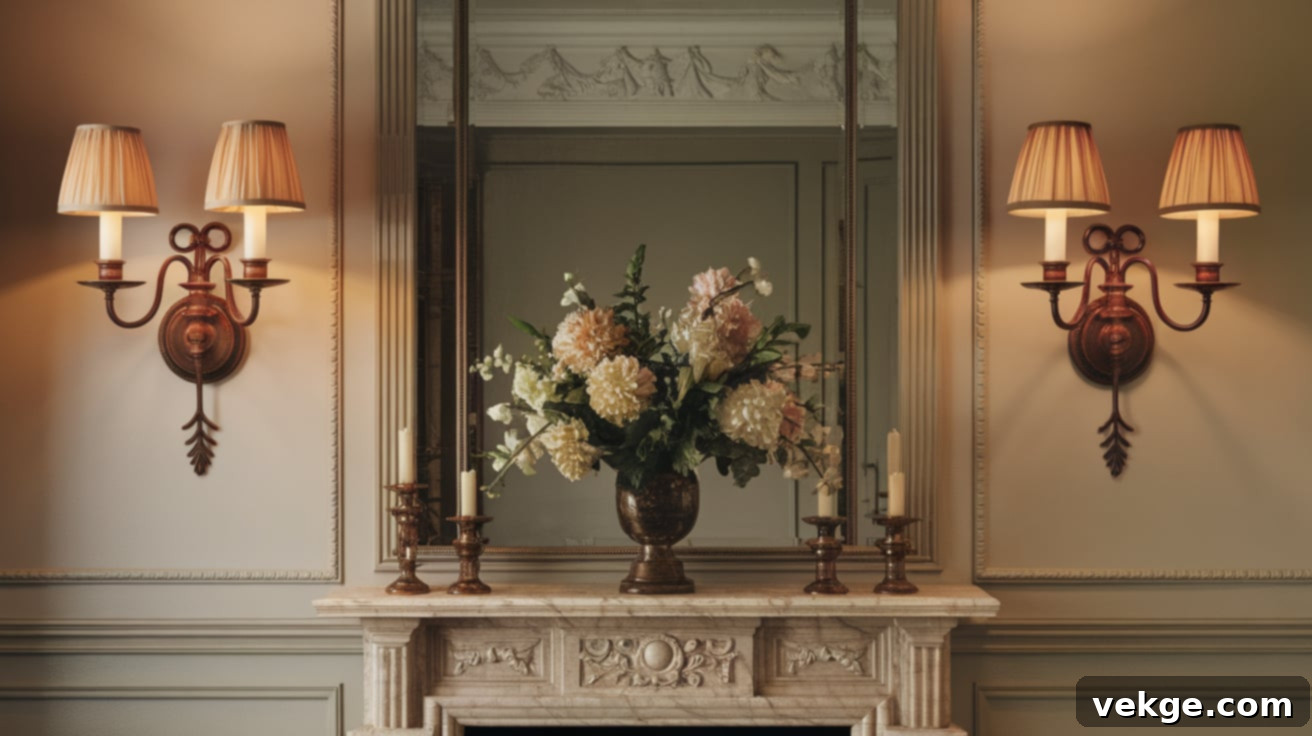
Wall sconces provide a wonderfully soft and atmospheric side lighting in Victorian rooms, adding depth and intimacy. These fixtures typically feature elegant metal bases and delicate fabric shades designed to beautifully diffuse the light, creating a gentle glow. Older designs sometimes incorporated mirrors behind the light source to amplify brightness in the era before efficient electric bulbs. Pairs of sconces were often strategically placed on either side of a fireplace mantel, doorways, or large artworks to achieve balanced, symmetrical illumination. Modern versions maintain this classic, refined aesthetic but are, of course, updated with electric bulbs for convenience and safety.
30. Table Lamps with Beaded Fringe
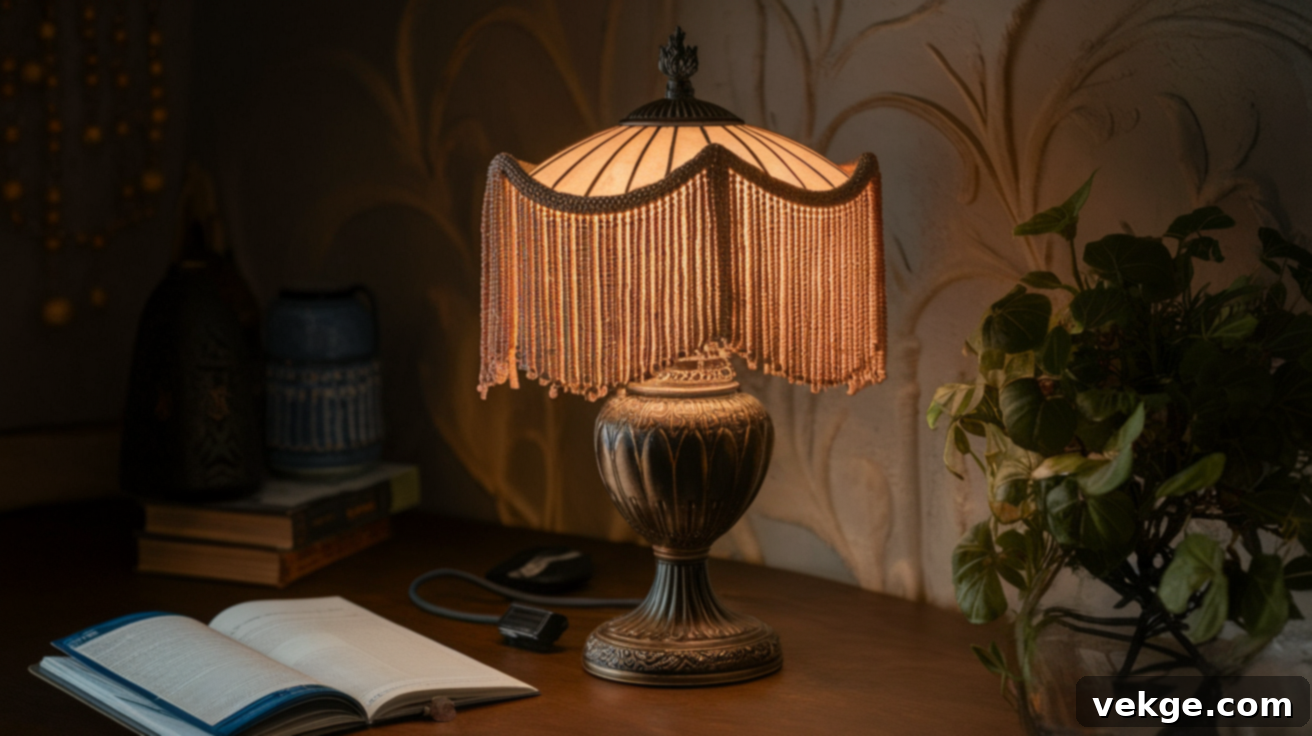
Table lamps adorned with charming beaded fringes were a common and delightful sight in Victorian rooms, adding both color and subtle motion. Their painted glass shades often featured delicate small glass beads gracefully hanging from the edges, which would gently sway with the slightest air movement, introducing a touch of whimsical elegance. Lamp bases were typically crafted from polished brass, decorative ceramic, or painted metal, frequently featuring nature-themed designs. Today, these lamps continue to provide a soft, inviting reading light while perfectly preserving an authentic Victorian look through their detailed craftsmanship and unique decorative elements.
31. Fireplace Candles in Candelabras
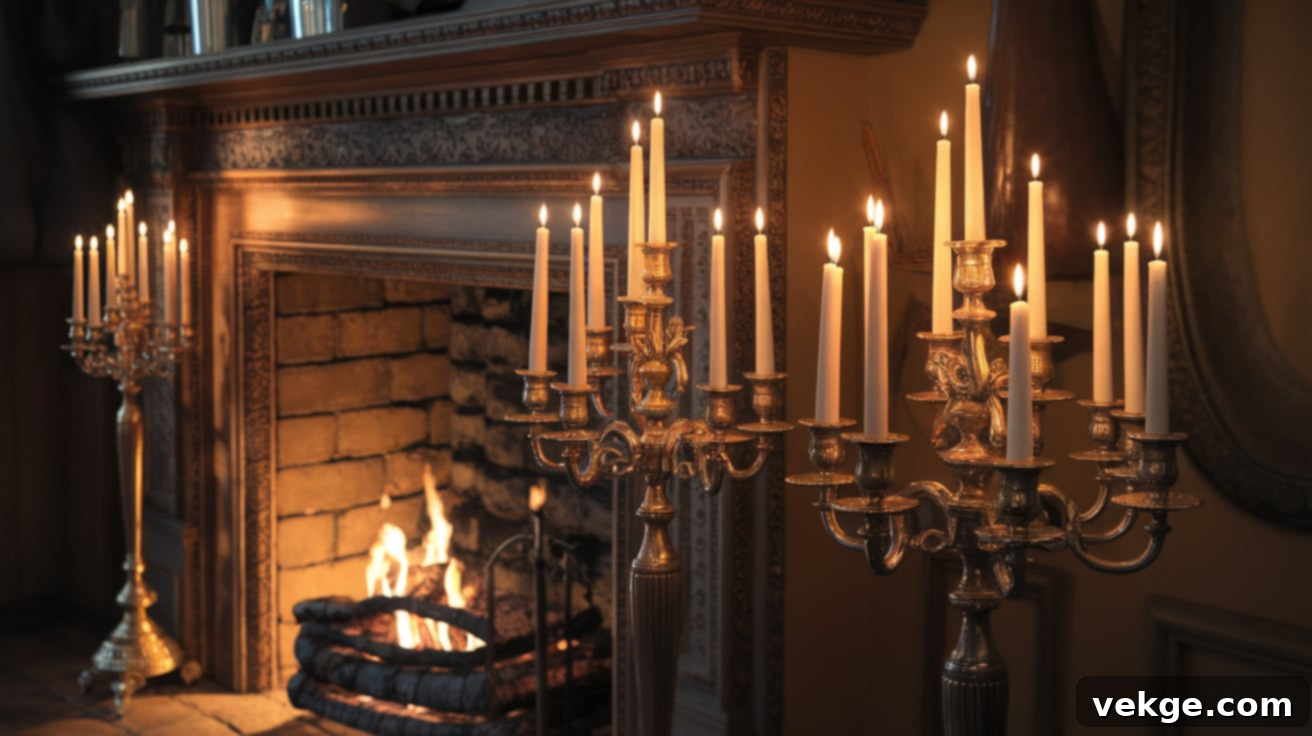
Even a non-functional fireplace can become a source of warm, inviting light with the addition of candelabras. Placing multiple-armed candelabras, typically holding three to seven candles, within or around a fireplace hearth instantly creates a cozy, romantic atmosphere reminiscent of Victorian evenings. These elegant holders were often placed on mantels or nearby side tables, strategically positioned near seating areas. The flickering flames cast enchanting moving shadows that animate walls and ceilings, adding a dynamic, living quality to the room. Modern interpretations can use real candles for special occasions or opt for battery-operated LED candles for a safe and convenient everyday classic look.
32. Victorian Sofa in a Minimalist Room
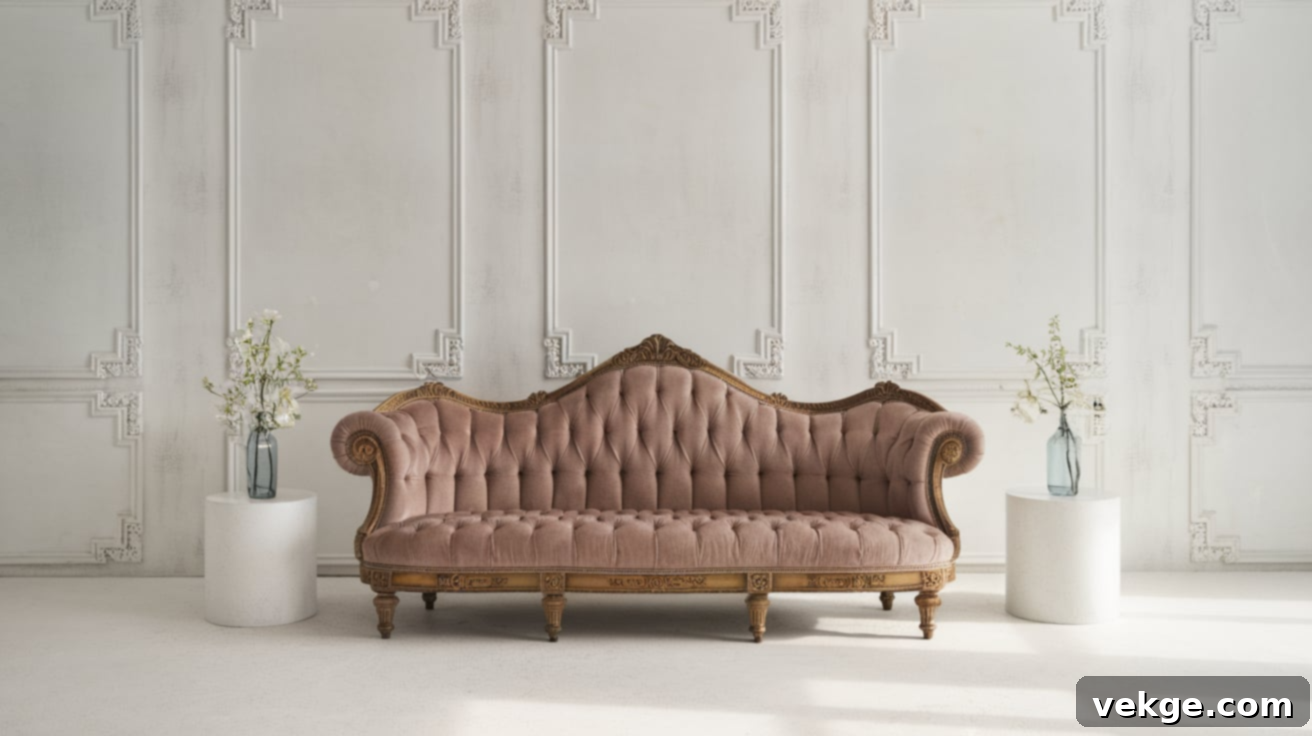
For a bold and contemporary twist on Victorian style, allow a single, exquisitely detailed Victorian sofa to become the striking focal point in an otherwise minimalist room. Its intricate tufting, carved wood details, and luxurious fabric will create a captivating contrast against clean, modern walls, generating immense visual interest. Opt for white or light gray walls to truly let the sofa command attention and highlight its craftsmanship. Complement this statement piece with just a few simple, sleek items nearby, such as a minimalist metal coffee table and a modern floor lamp. This approach beautifully showcases the artistry of Victorian furniture without cluttering the space, allowing the sofa’s rich texture and form to provide all the necessary decorative detail.
33. Green Accent Wall with Sleek Gold Fixtures
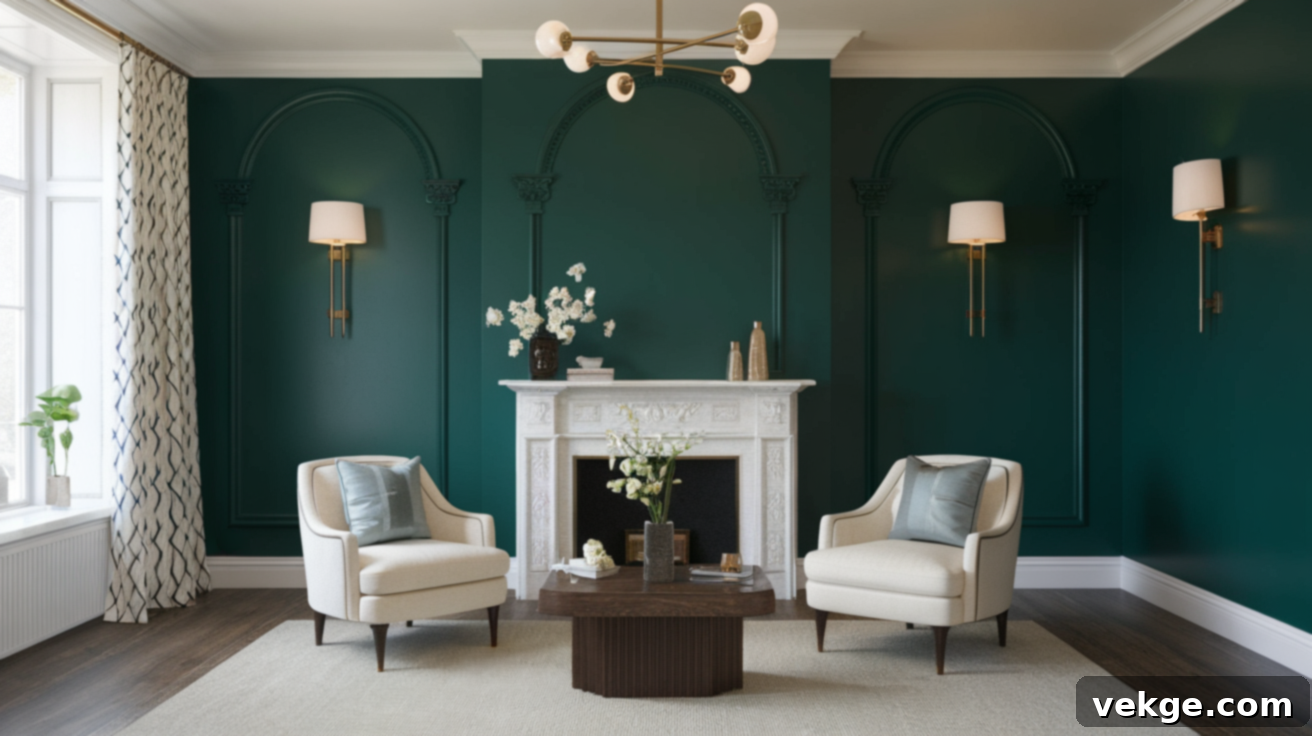
Introduce a modern interpretation of Victorian richness by painting one accent wall in a deep, luxurious green. This bold color choice, a nod to classic Victorian palettes, feels fresh and vibrant when paired with sleek, contemporary gold light fixtures featuring clean, minimalist lines. The resulting aesthetic is remarkably current yet respectfully echoes the opulence of Victorian style. To prevent the room from feeling too dark or enclosed, keep the other walls in a neutral tone. This design strategy works particularly well in rooms that benefit from ample natural light. The sophisticated contrast between the deep green and the gleaming gold creates a balanced, updated look that is both striking and elegant.
34. Modern Art Framed in Antique Molding
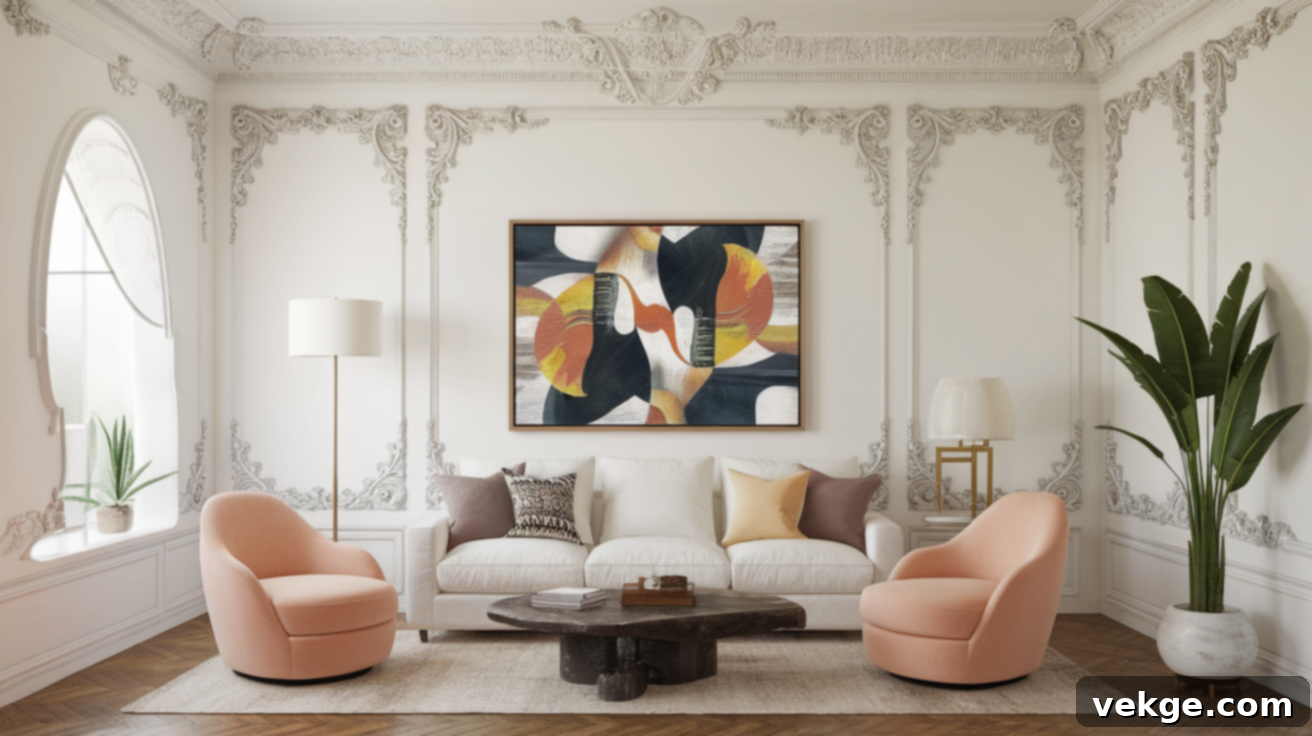
Create a fascinating dialogue between eras by showcasing modern or abstract art within an ornate, antique Victorian frame. This unexpected pairing generates a bold and captivating mix of old and new, instantly elevating both elements. The substantial, decorative frame imparts a sense of weight and importance to the contemporary artwork, while the modern art itself prevents the antique frame from feeling outdated or overly traditional. This concept works equally well for both original paintings and high-quality prints. For the most harmonious effect, select art that incorporates at least one color present in other decorative elements of the room, tying the distinct styles together seamlessly.
35. Neutral Victorian Decor with Black Accents
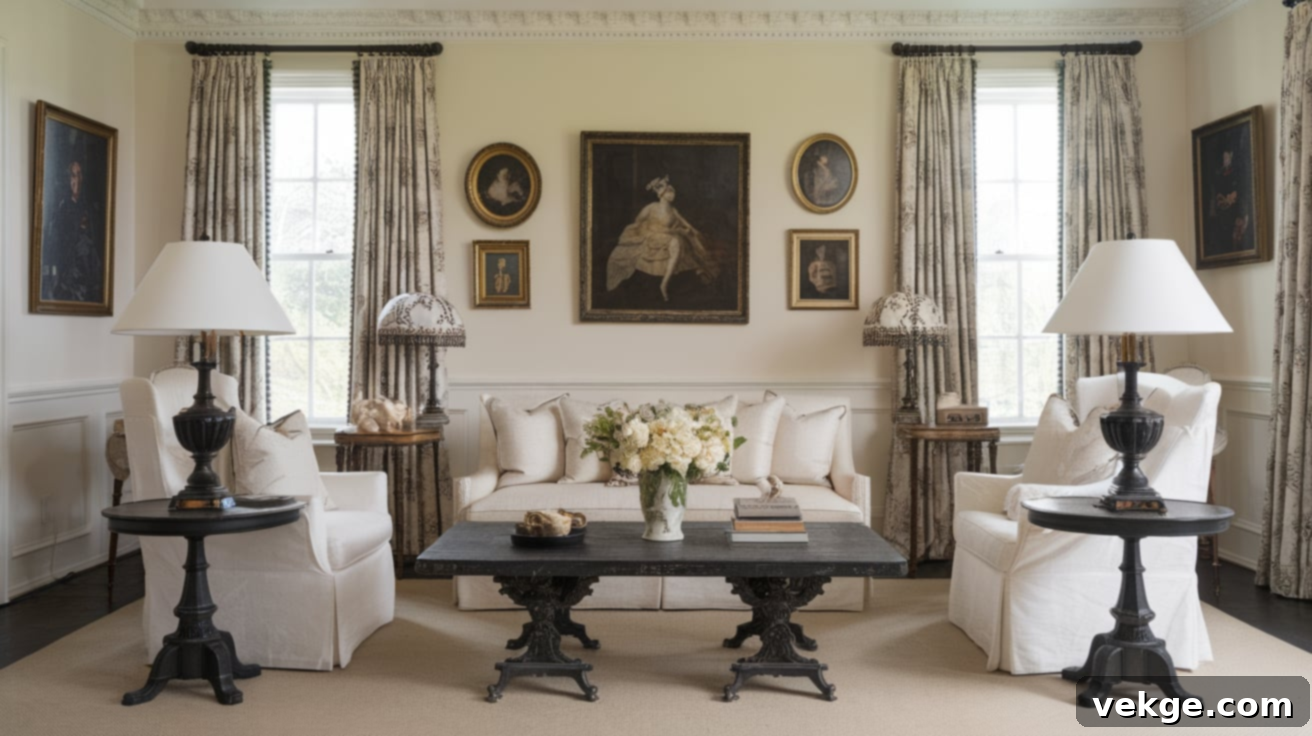
For a lighter, more contemporary take on Victorian opulence, choose Victorian-style furniture upholstered in a palette of whites, creams, and beiges. This neutral base offers a softer, airier interpretation of the style. Introduce crisp black accents through elements like picture frames, elegant lamp bases, or small side tables to provide striking contrast and essential definition. This sophisticated color scheme beautifully preserves the classic shapes and intricate details of Victorian furniture while feeling significantly more current than traditional dark brown woods. The neutral backdrop allows the graceful curves and delicate carvings of the furniture to become even more visible and appreciated.
36. Mirrored Fireplace Wall for Depth
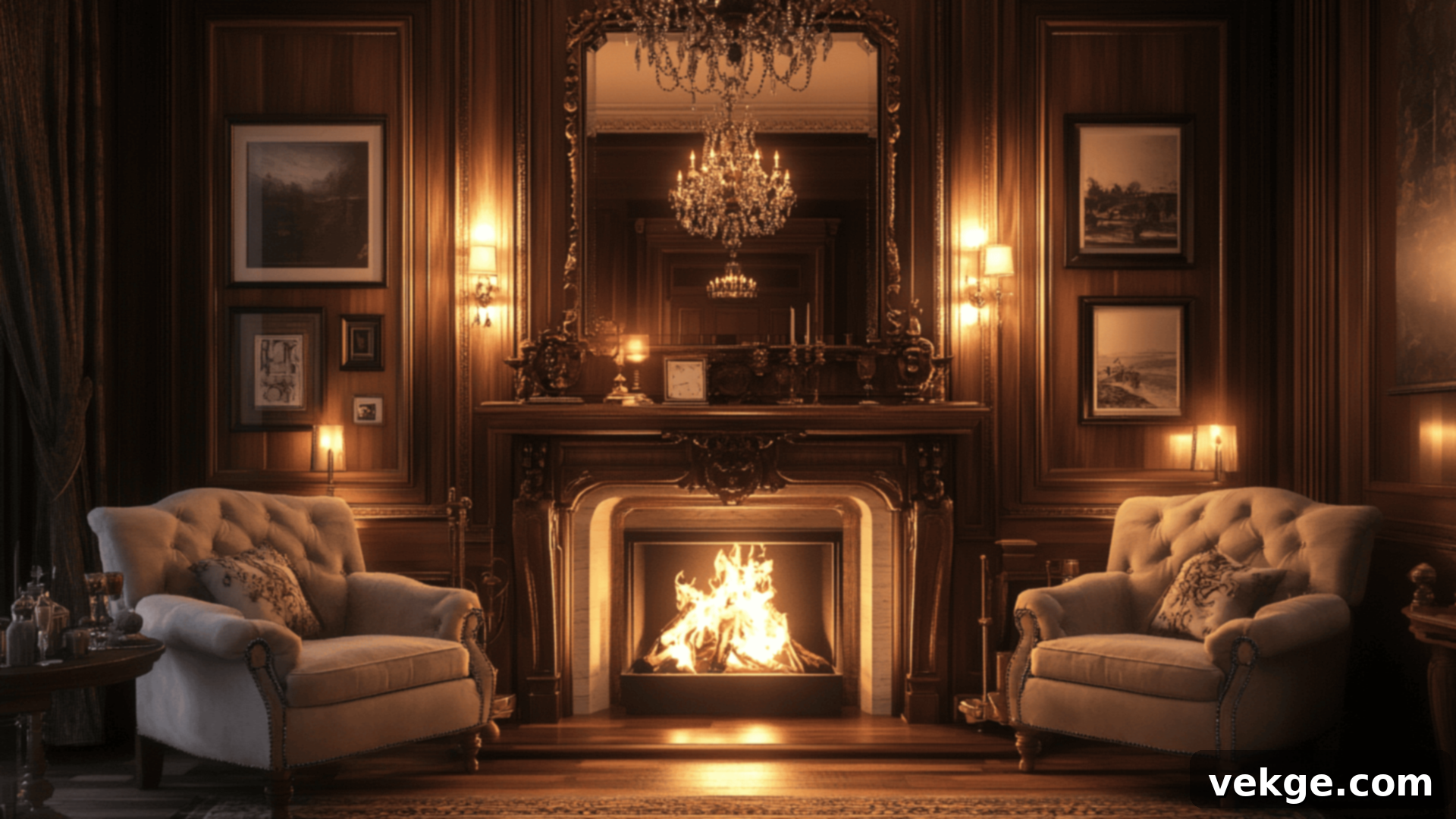
Transform a small Victorian room by covering the wall surrounding your fireplace with mirrors, effectively making the space feel twice its actual size. Mirrors are masters of illusion, reflecting light and creating the perception of greater depth and openness. Victorian homes frequently employed this clever trick to visually expand narrow sitting rooms. Select mirrors with beautifully carved frames and a slight, authentic patina to enhance the period character. Strategically place lamps or candles where their light will be reflected in the mirrors, multiplying their luminous effect during evening hours. This treatment is particularly effective on the shortest wall in rectangular rooms, creating a dramatic and expansive visual impact.
37. Slimline Furniture with Victorian Details
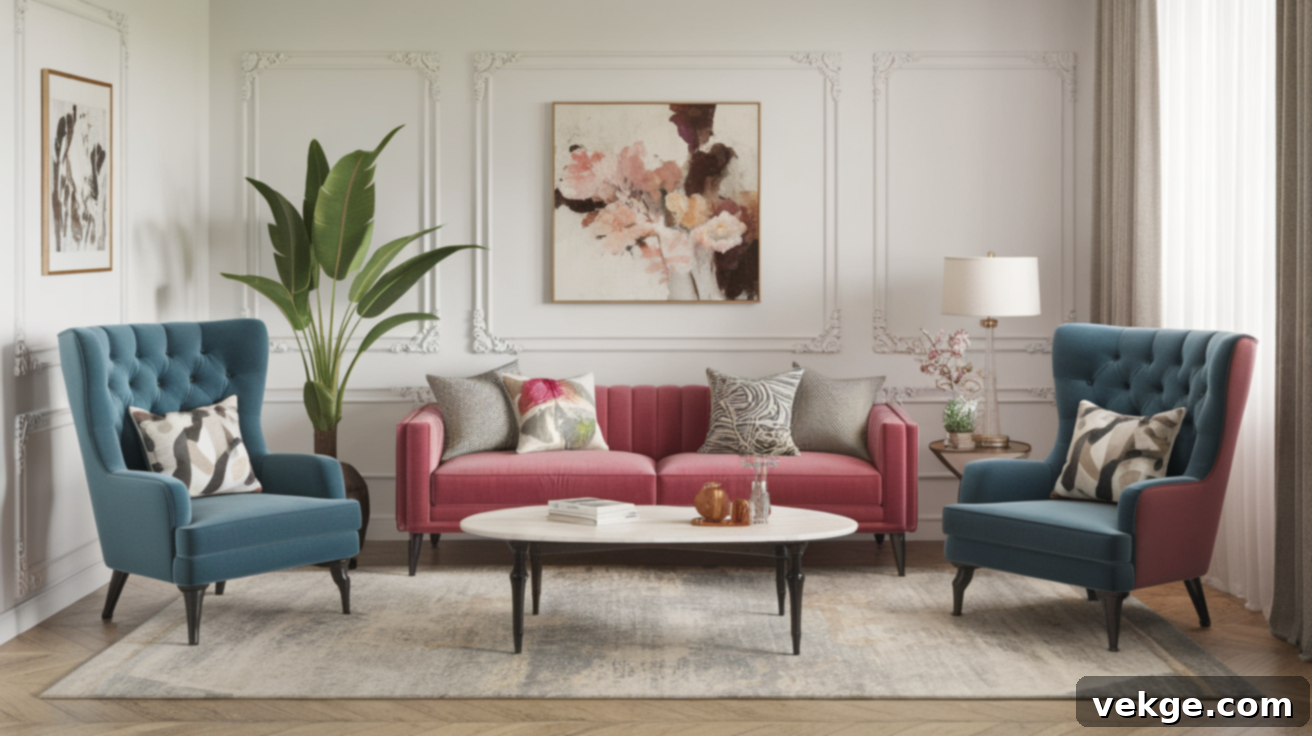
For those working with smaller spaces, slimline Victorian-style furniture offers an ideal solution, preserving period charm without overwhelming the room. Opt for tufted sofas and chairs with rolled arms but in more compact dimensions. Furniture pieces featuring exposed legs rather than heavy skirts allow more of the floor to be seen, which in turn makes rooms feel larger and more open. These streamlined versions meticulously retain the elegant curved lines and intricate wood details characteristic of Victorian style, ensuring that even in a cozy space, the grandeur of the era is beautifully represented without sacrificing precious square footage.
38. Corner Display Shelf for Collectibles
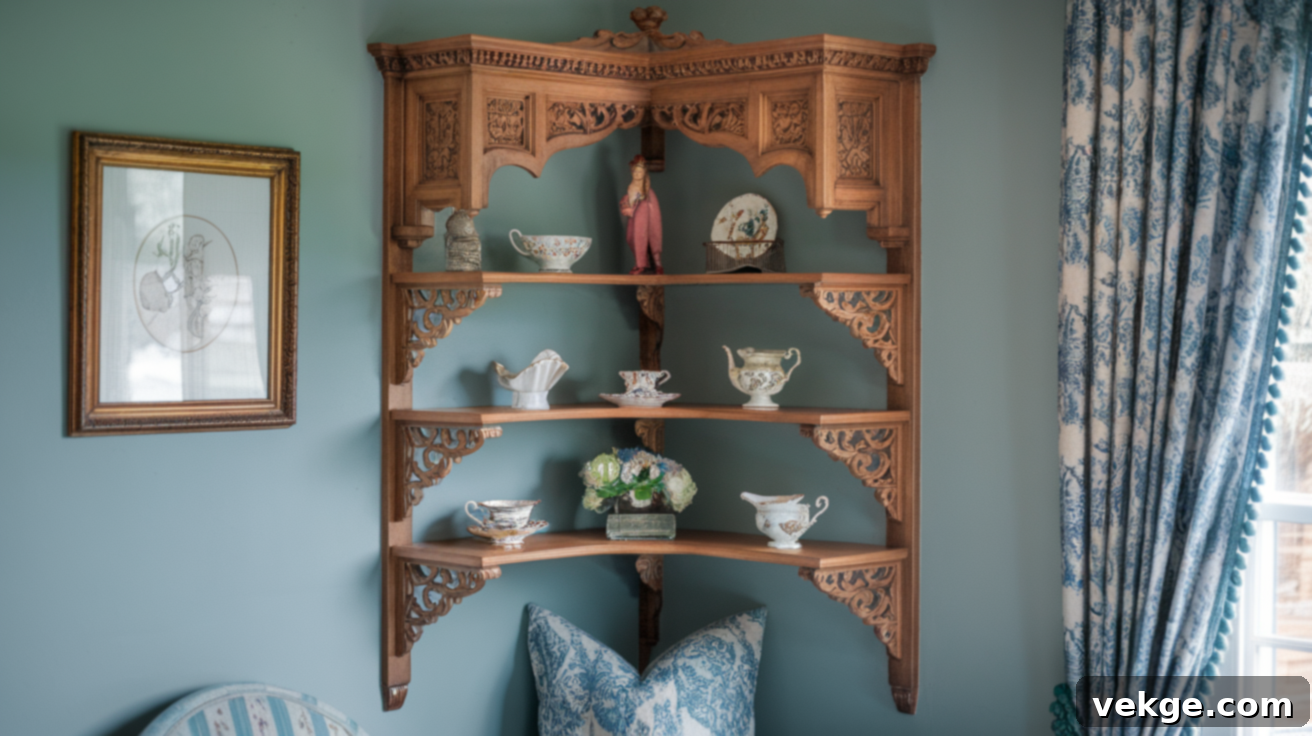
Maximize often-underutilized space by installing corner display shelves, perfect for showcasing your treasured Victorian collections. These clever triangular units fit snugly into corners, making efficient use of vertical space with minimal impact on floor area. They are ideal for exhibiting smaller, delicate items such as antique teacups, miniature paintings, or charming figurines, adding character and personality without contributing to clutter. Wooden versions with delicate carved details further enhance the period look while elegantly resolving spatial challenges. Moreover, corner shelves draw the eye upward, creating the illusion of taller ceilings and a more expansive feel.
39. Pale Colors with High-Contrast Trim
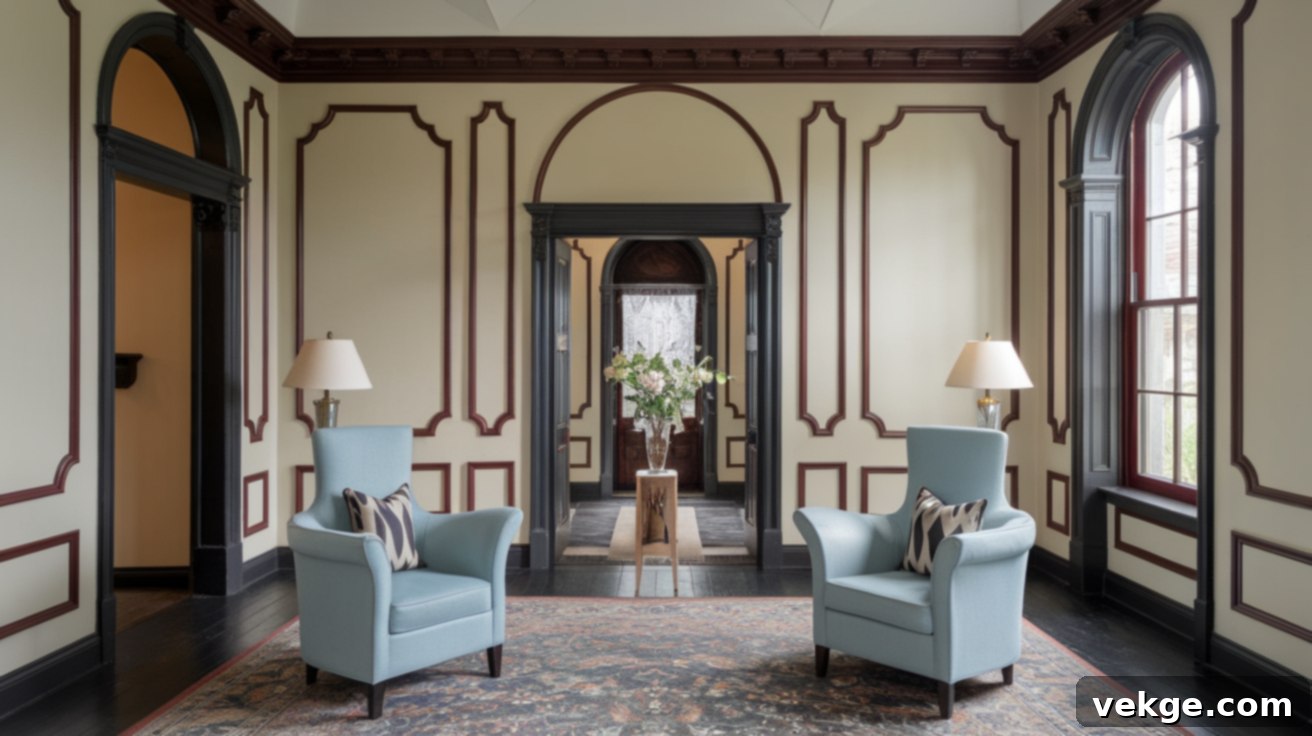
Achieve Victorian elegance in smaller rooms by pairing light-colored walls with high-contrast trim. Walls painted in soft cream, pale blue, or gentle green create an airy, open feel, preventing the space from feeling enclosed. Then, introduce striking definition with trim painted in a dark or bold color like black, navy, or deep burgundy around doors, windows, and ceiling lines. This approach maintains the classic Victorian penchant for dramatic contrast while ensuring maximum light reflection, keeping the room bright and inviting. This strategy is especially effective when applied to detailed molding, which gains added shadow and depth from the contrasting colors.
Victorian Sitting Room Tips for Small Spaces
Even modest rooms can beautifully embody Victorian style with the right design choices. The key is to be strategic, using lighter colors, reflective surfaces like mirrors, and compact furniture with authentic period details to create an inviting atmosphere without feeling crowded or overwhelming.
- Embrace Lighter Hues: Instead of traditional deep, heavy colors for your main wall treatments, try lighter, muted versions of those rich shades. Soft greens, pale blues, or even a sophisticated cream can open up the space while still nodding to the Victorian palette.
- Utilize Mirrors Strategically: Mirrors are your best friend in small spaces. A large gilded mirror, especially opposite a window or a light source, will reflect light and create the illusion of greater depth and space, making the room feel more expansive.
- Select Compact, Tufted Furniture: Choose scaled-down versions of classic Victorian pieces. Look for compact tufted sofas and chairs with vintage touches like rolled arms, button detailing, and elegant exposed legs. These pieces provide character without consuming too much floor space.
The secret is to focus on a few key elements rather than attempting to incorporate every single Victorian detail. Begin with light wall treatments or opt for wallpapers featuring smaller, more delicate patterns to ensure the room maintains an open and airy feel. When selecting furniture, prioritize pieces with authentic Victorian features such as intricate button tufting, gracefully curved wood, and elegantly turned legs, but in sizes proportionate to your room. A small settee, for example, can serve as a charming alternative to a full-sized sofa, and a single, well-chosen wingback chair can become a captivating focal point.
Finally, keep accessories meaningful but not overwhelming. Opt for a few standout items like gleaming crystal candlesticks, a framed portrait, or a decorative clock. Group smaller collections artfully on a single shelf or within a glass-front cabinet to maintain a sense of order and elegance without creating visual clutter. Thoughtful curation is paramount in a smaller Victorian-inspired space.
Final Thoughts
A truly captivating Victorian sitting room is more than just a collection of old items; it’s a space that tells a story, often through the accumulation of small, cherished details. You certainly don’t need to fill your home exclusively with antiques to achieve this look. Instead, the magic lies in carefully selecting the elements that resonate with you and complement your lifestyle.
From my experience, the most successful Victorian-inspired interiors beautifully blend old and new. Perhaps a sumptuously soft, patterned rug anchors the room, while a meticulously carved side table adds historical charm. It’s the thoughtful layering of these pieces that truly brings the space to life. What genuinely makes these rooms feel special is the attention to intricate detail: the subtle pattern on a decorative pillow, the elegant curve of a chair leg, or even the nuanced color choice for the wall trim.
These spaces feel inherently warm, inviting, and wonderfully full precisely because they masterfully play with texture, color, and form in ways that many modern minimalist rooms often forgo. They offer a sanctuary of comfort and beauty, a place to relax and be inspired.
I’m eager to hear your thoughts! Let me know in the comments below which Victorian sitting room idea you’re most excited to try first. I’d genuinely love to hear what speaks to you most about this enduring style.
